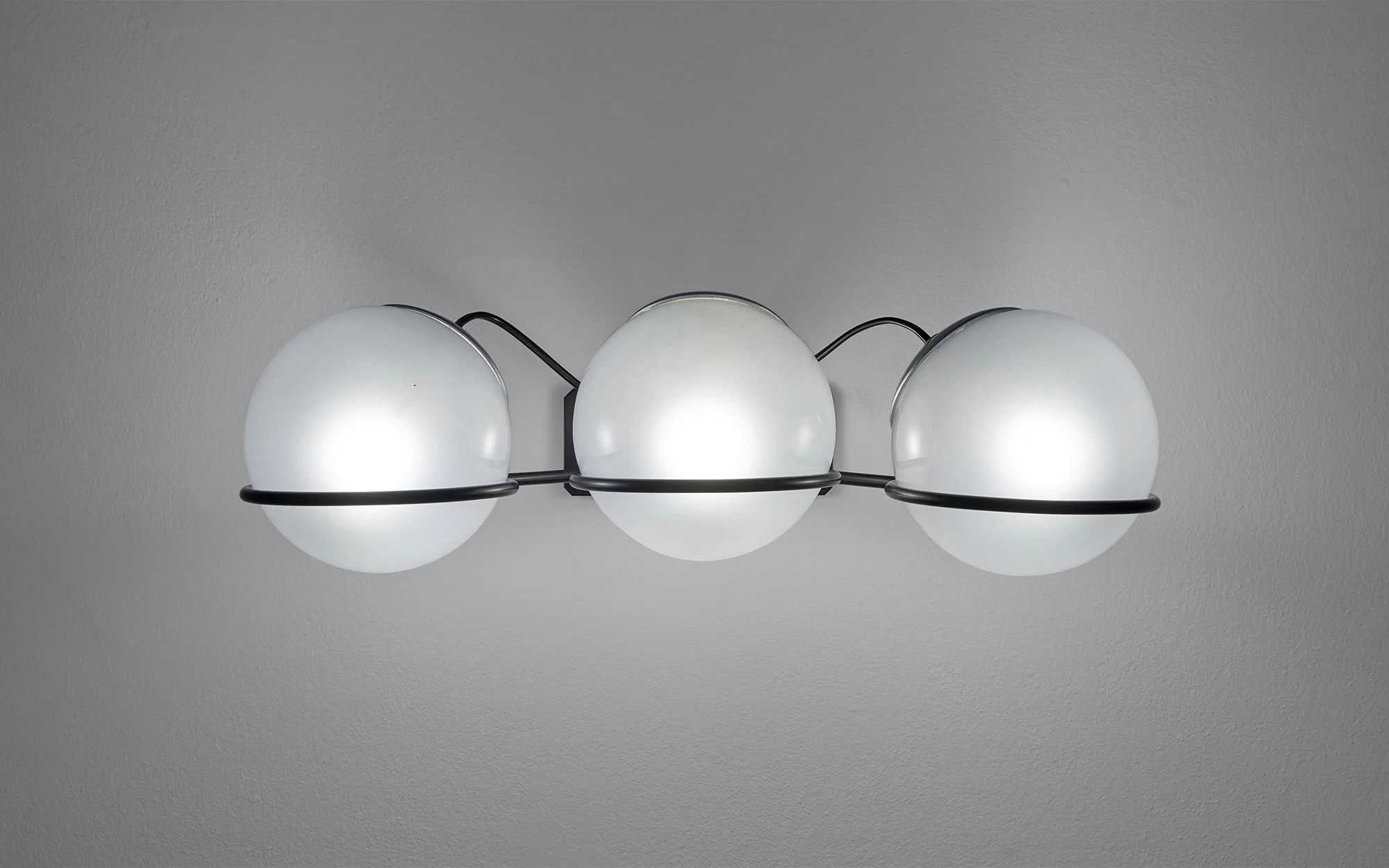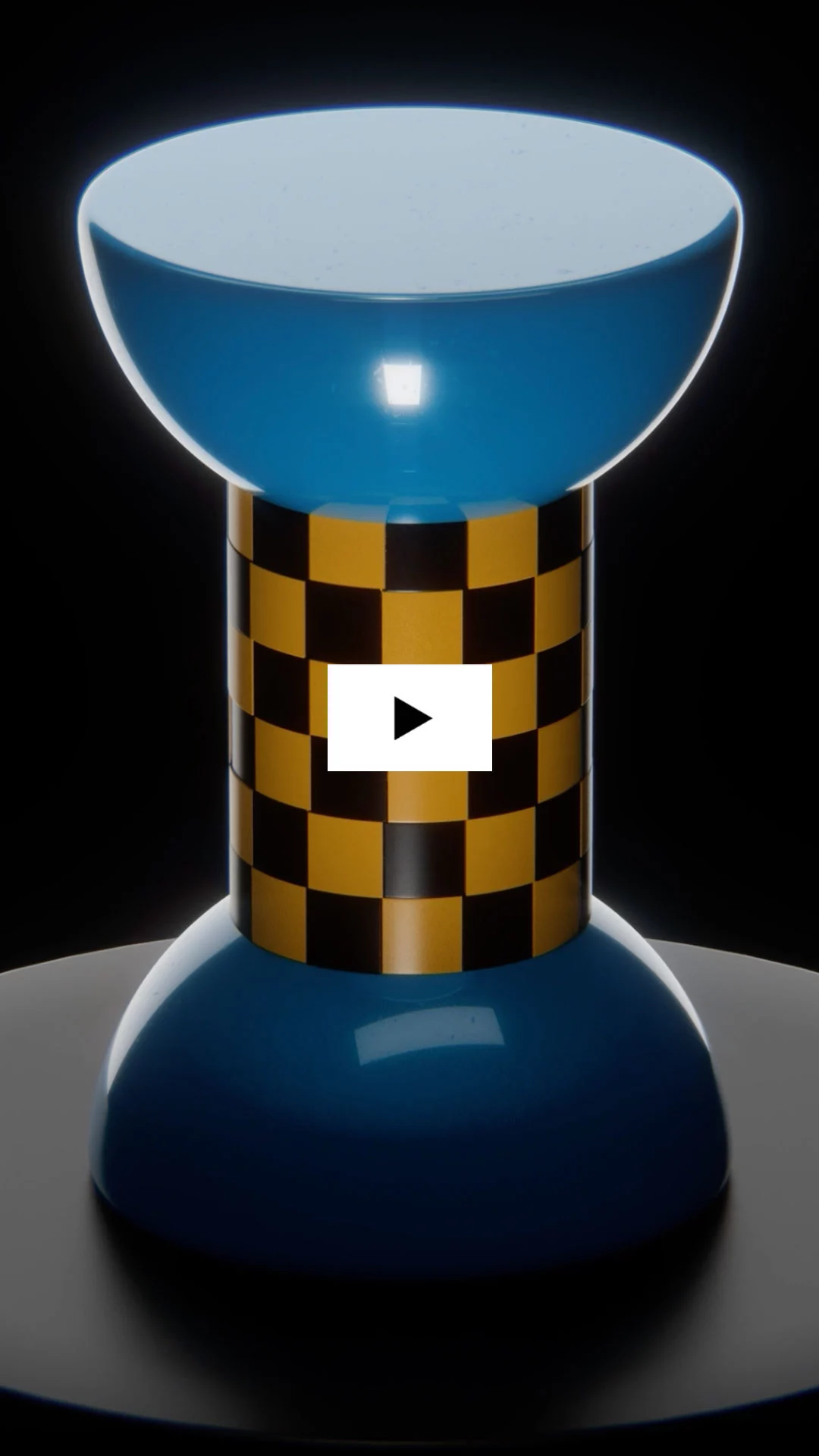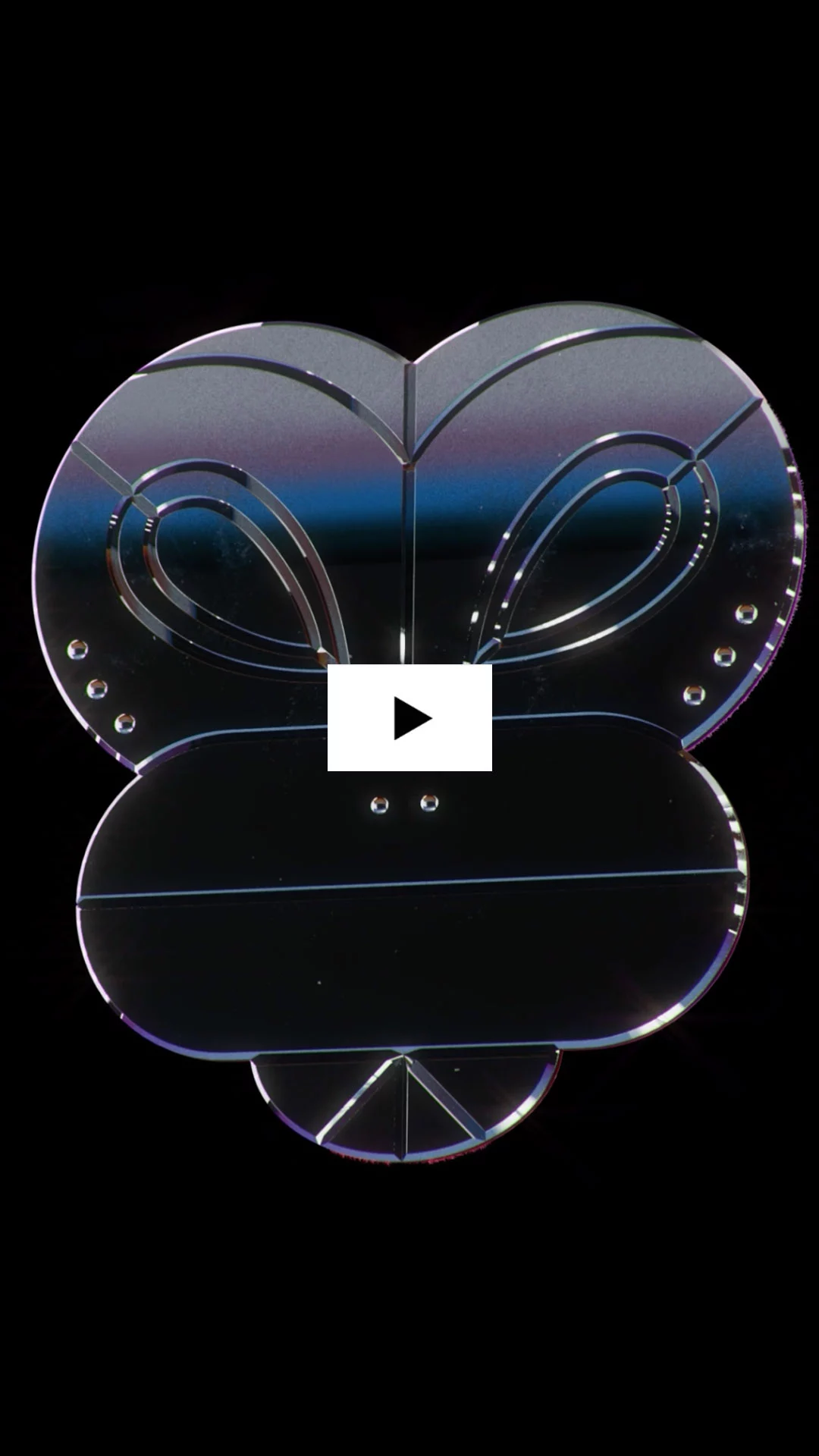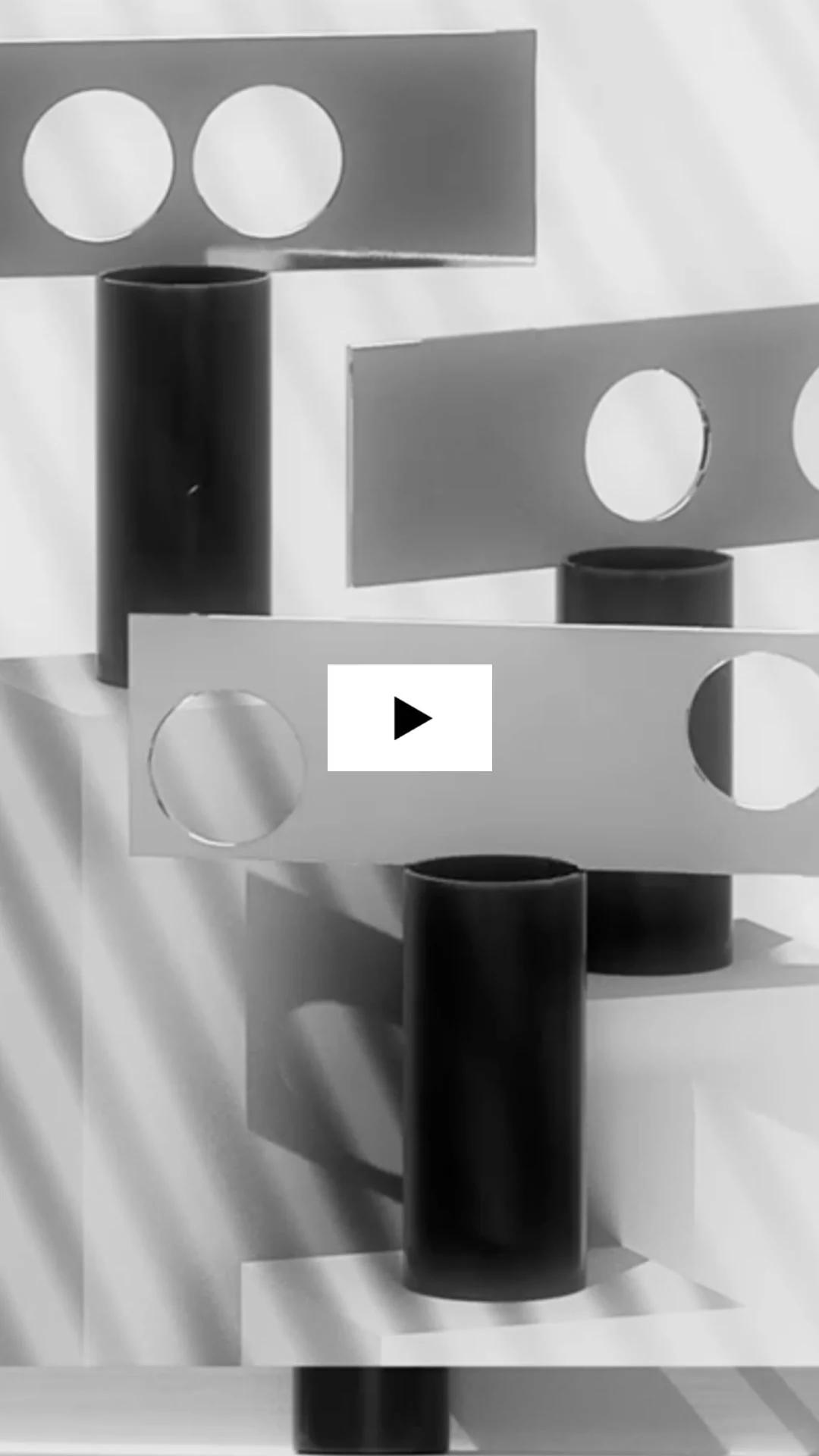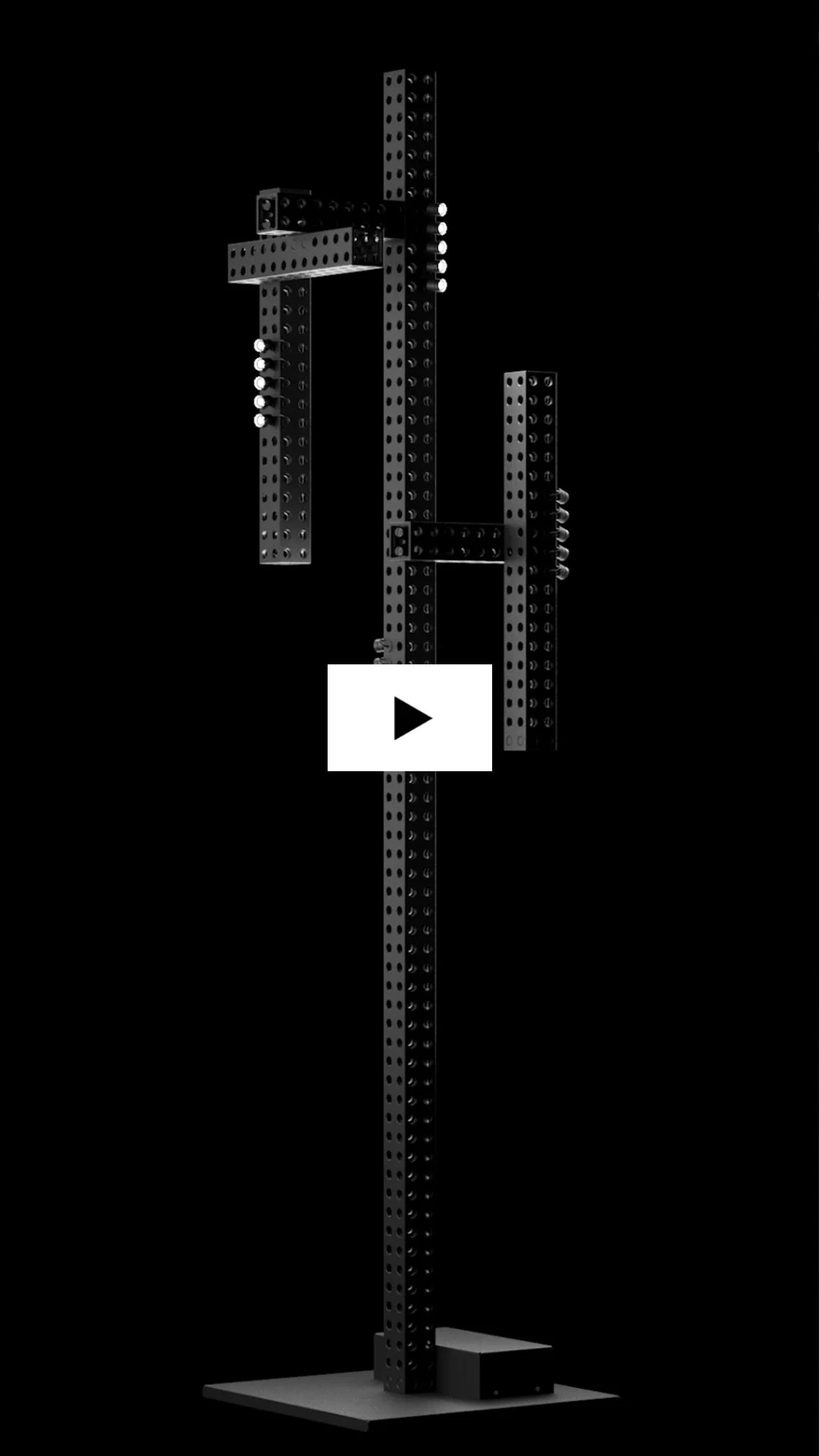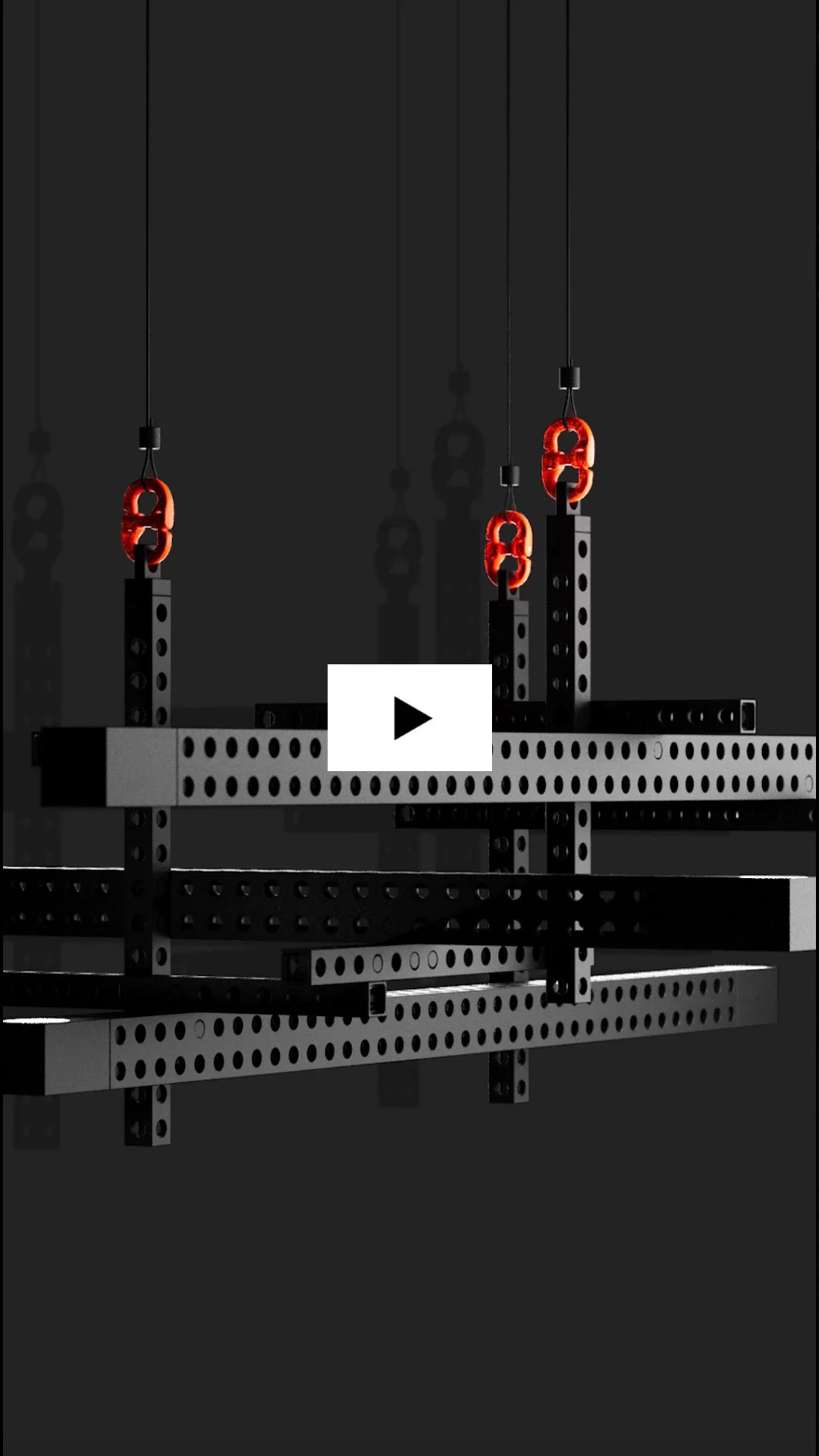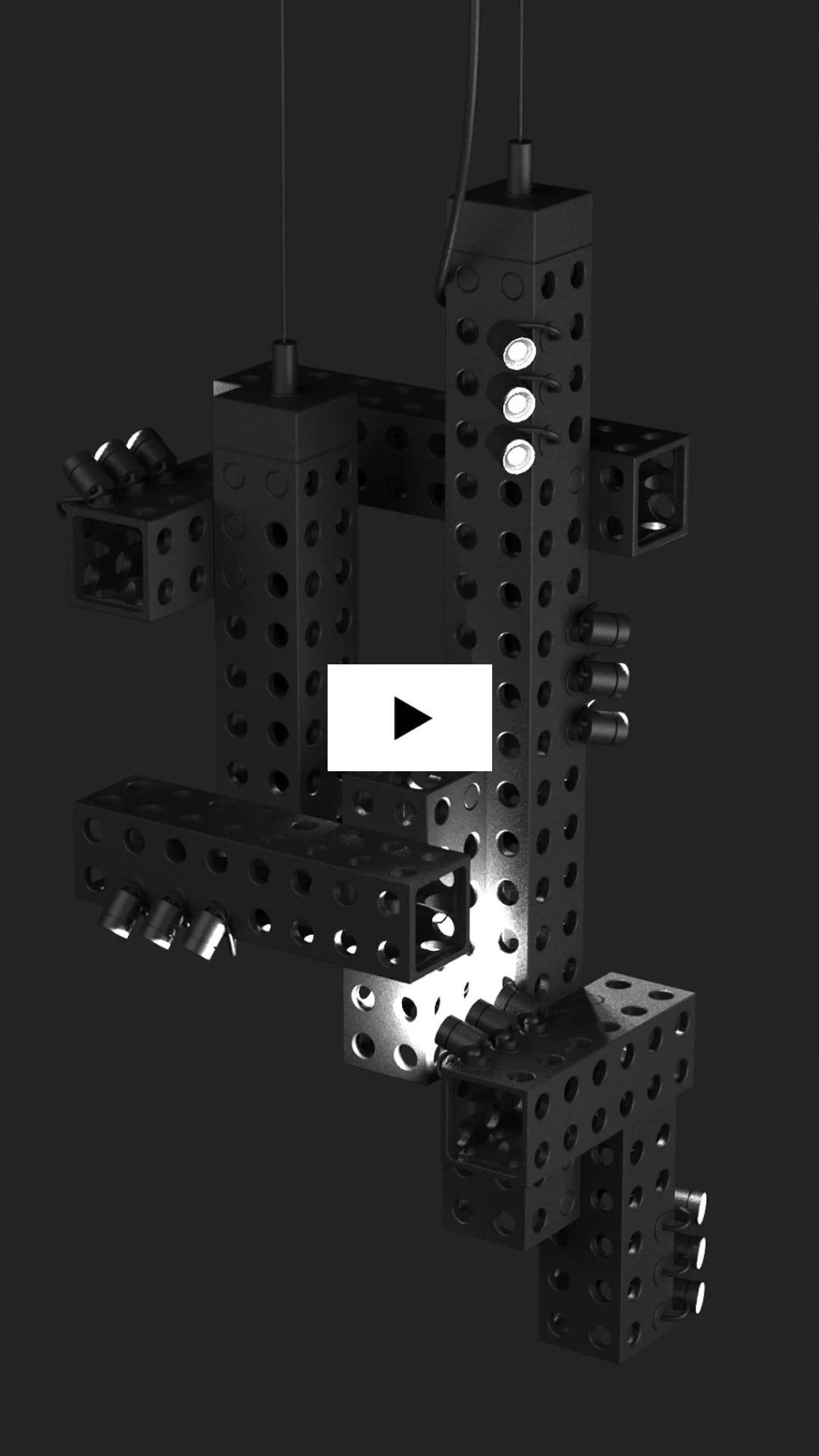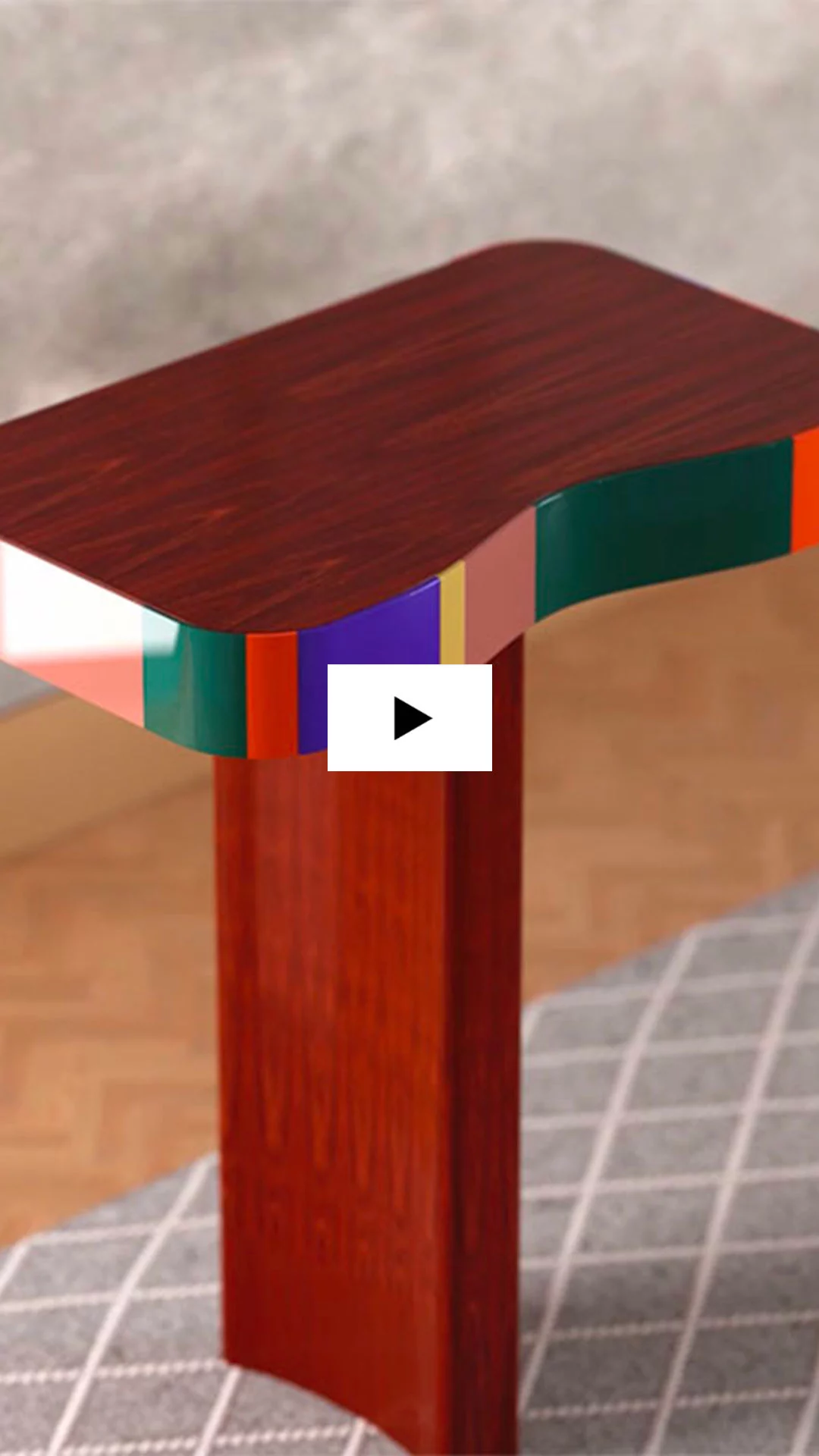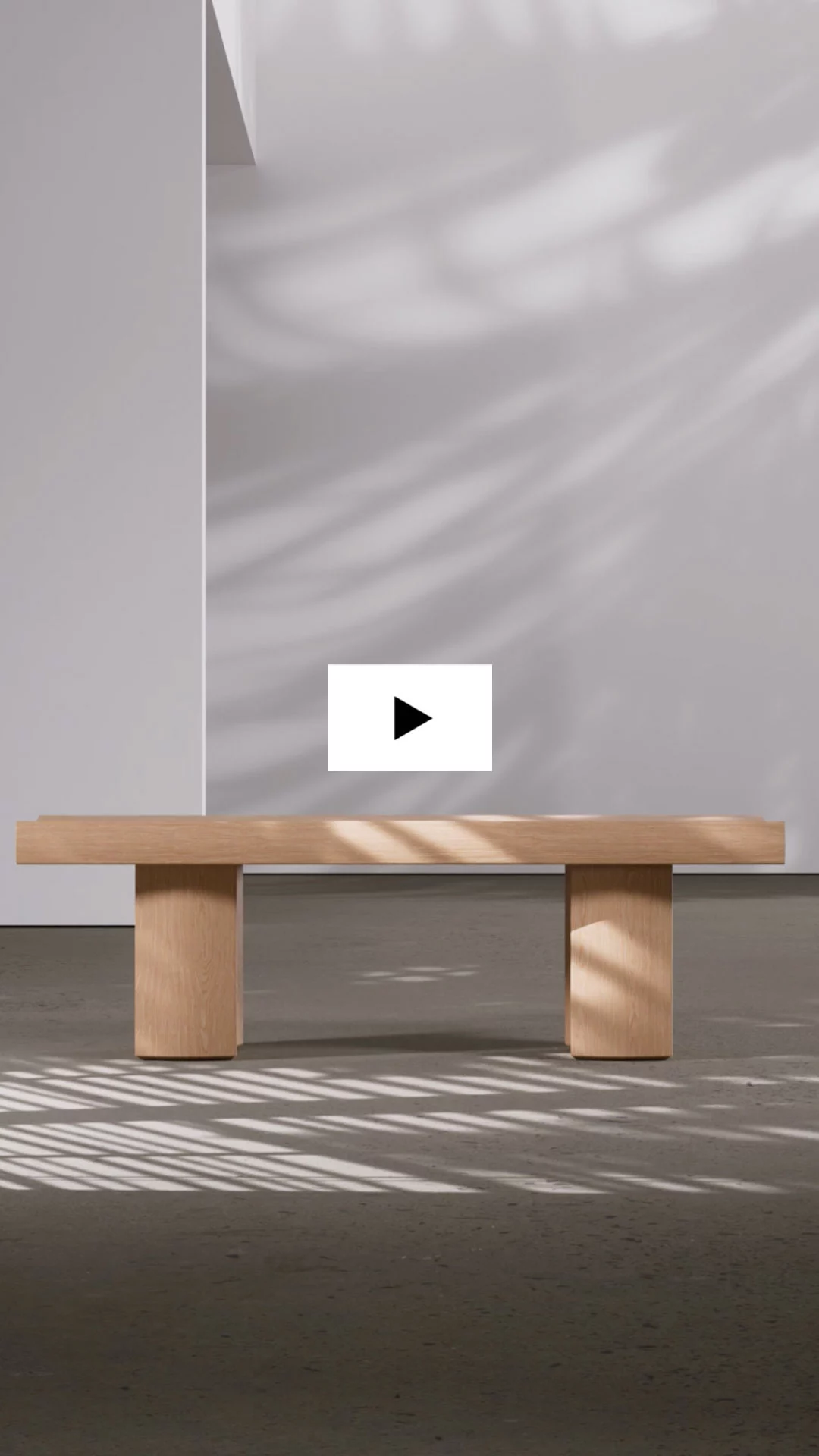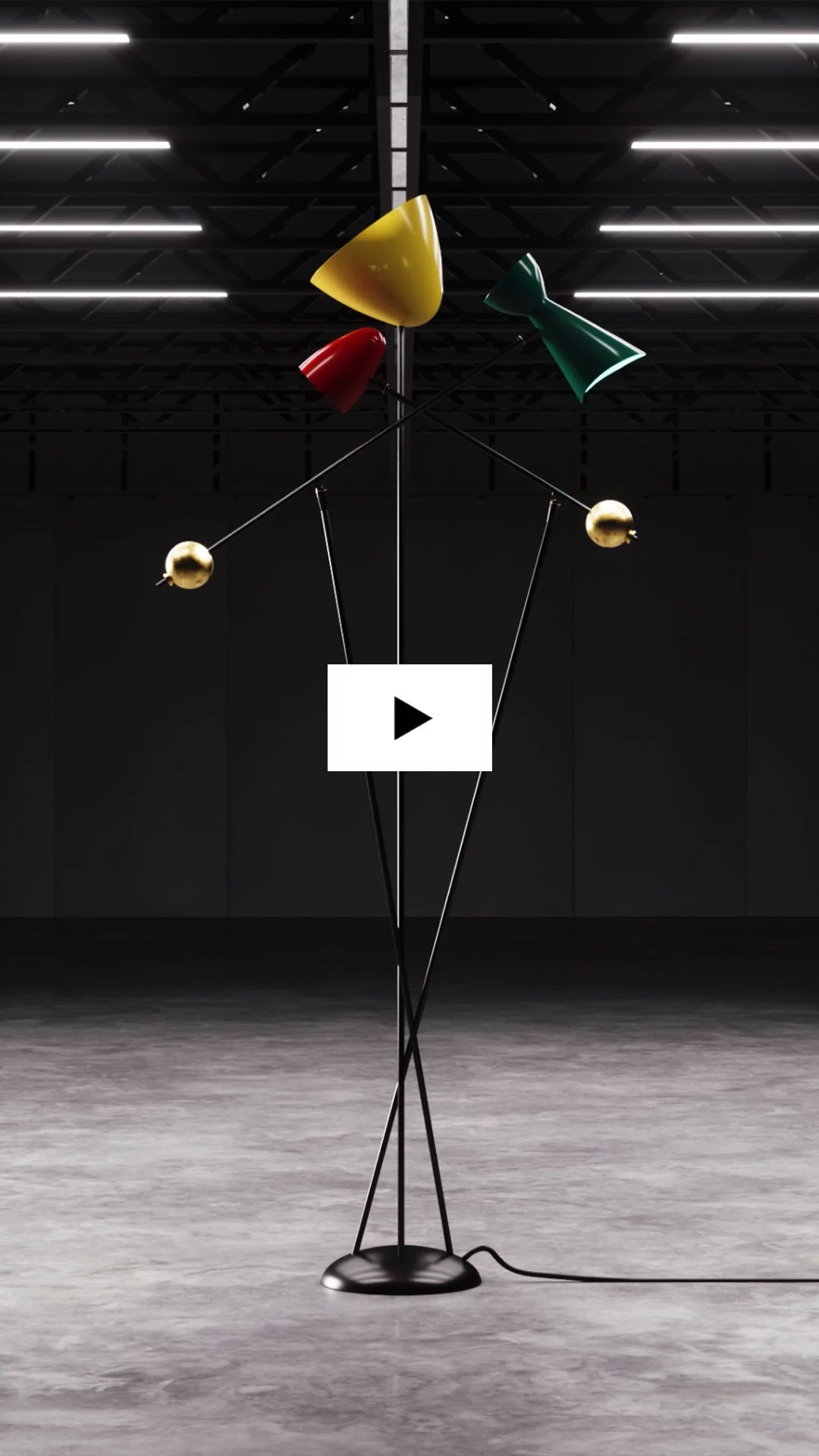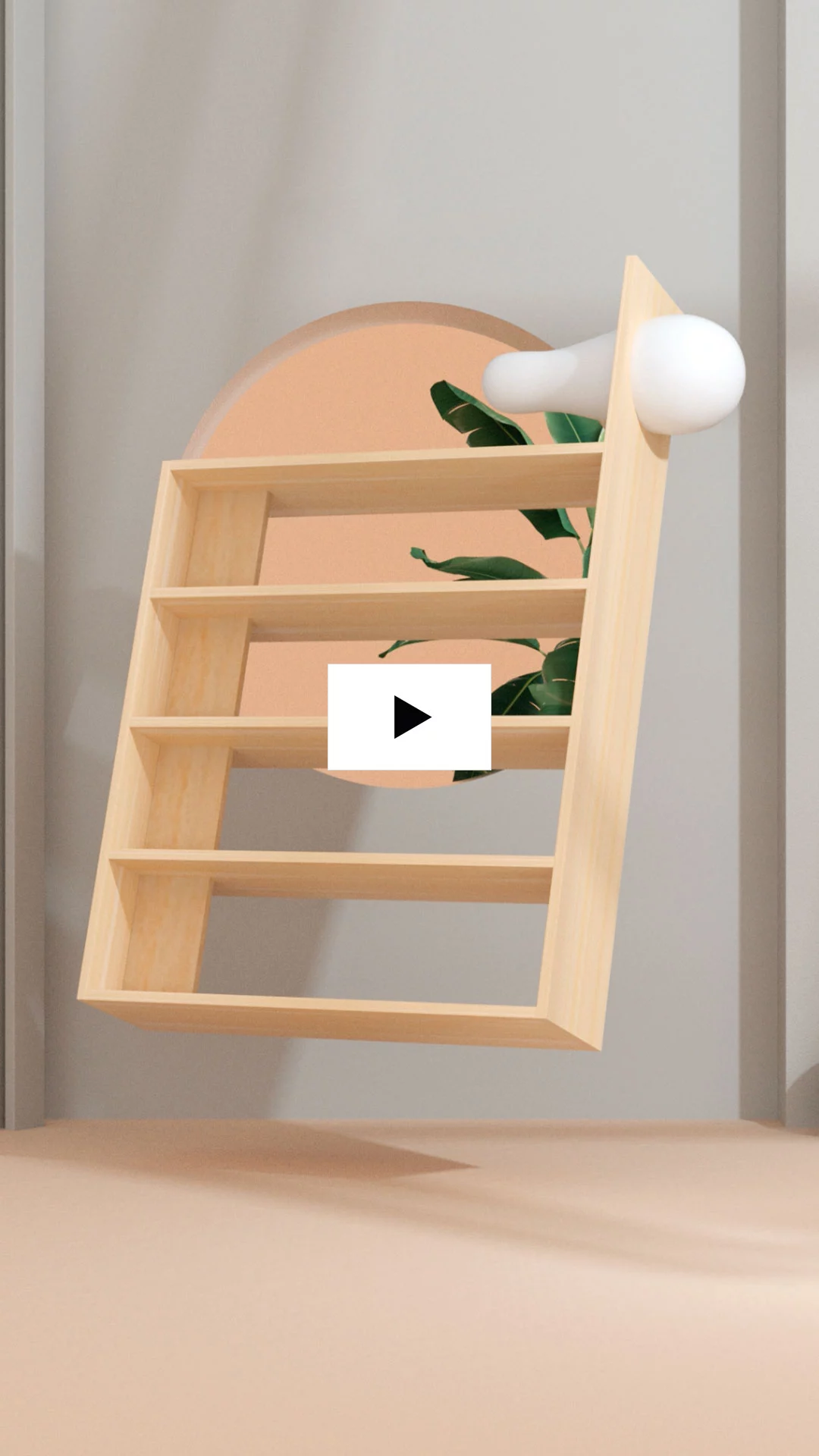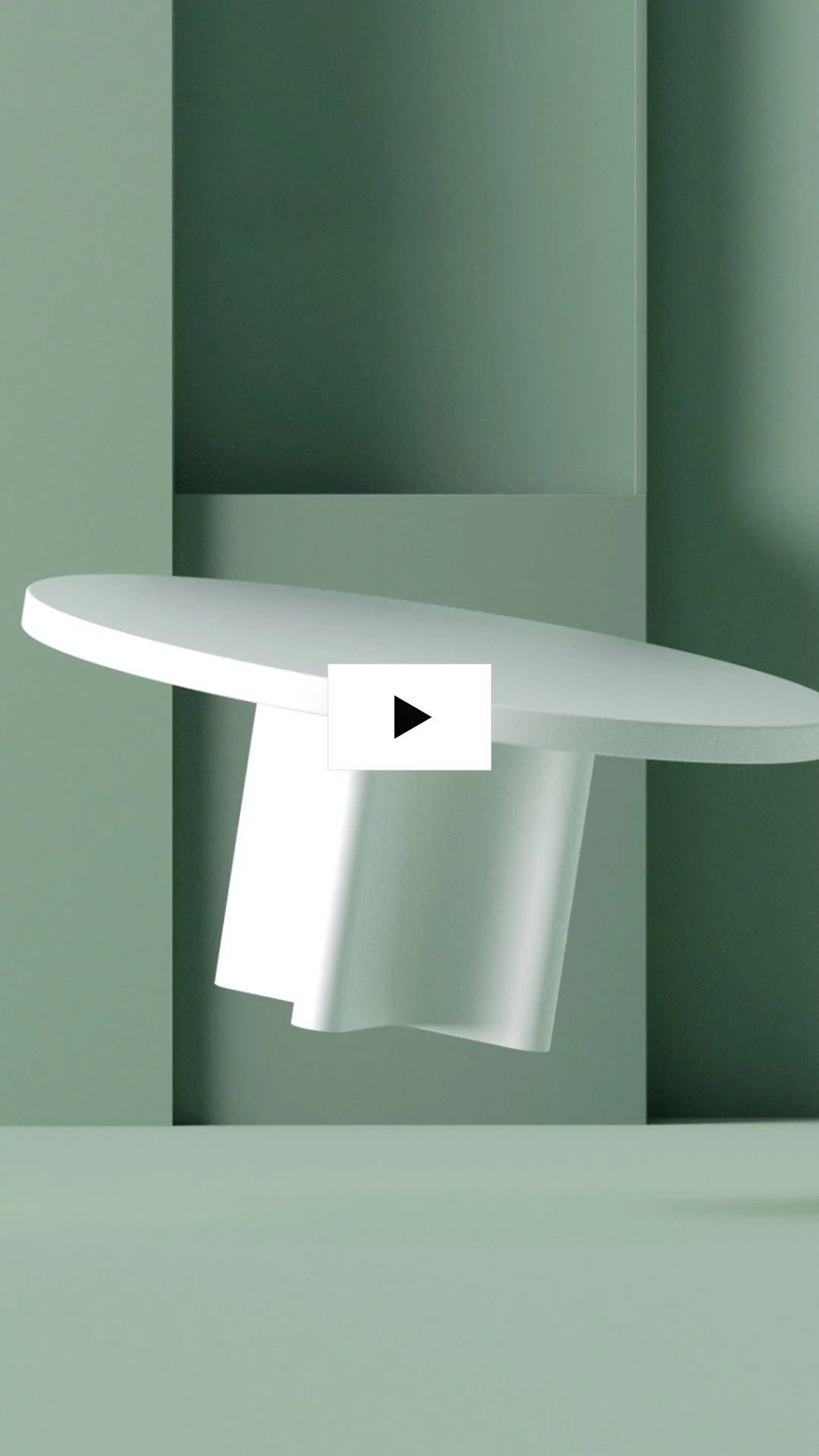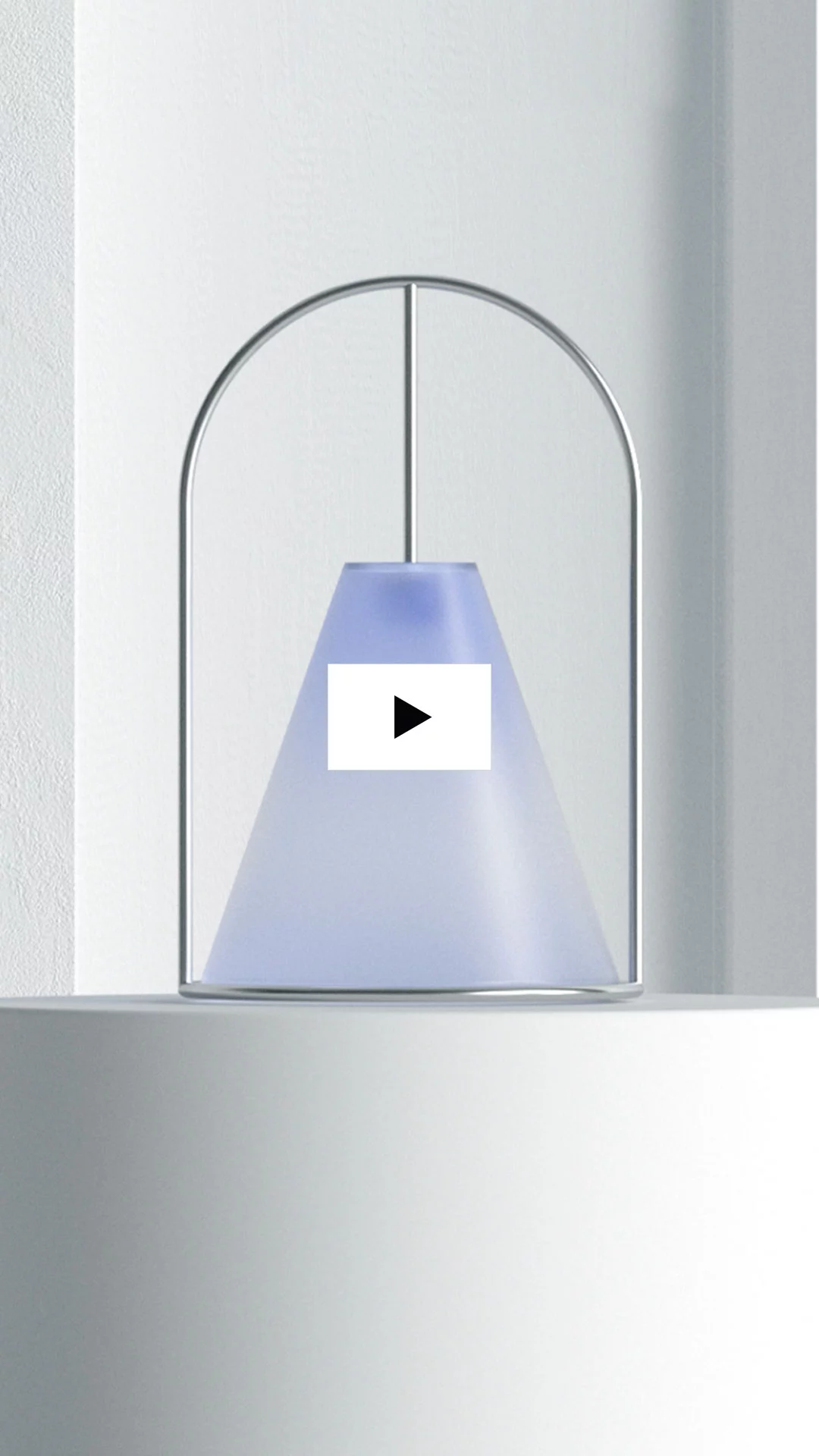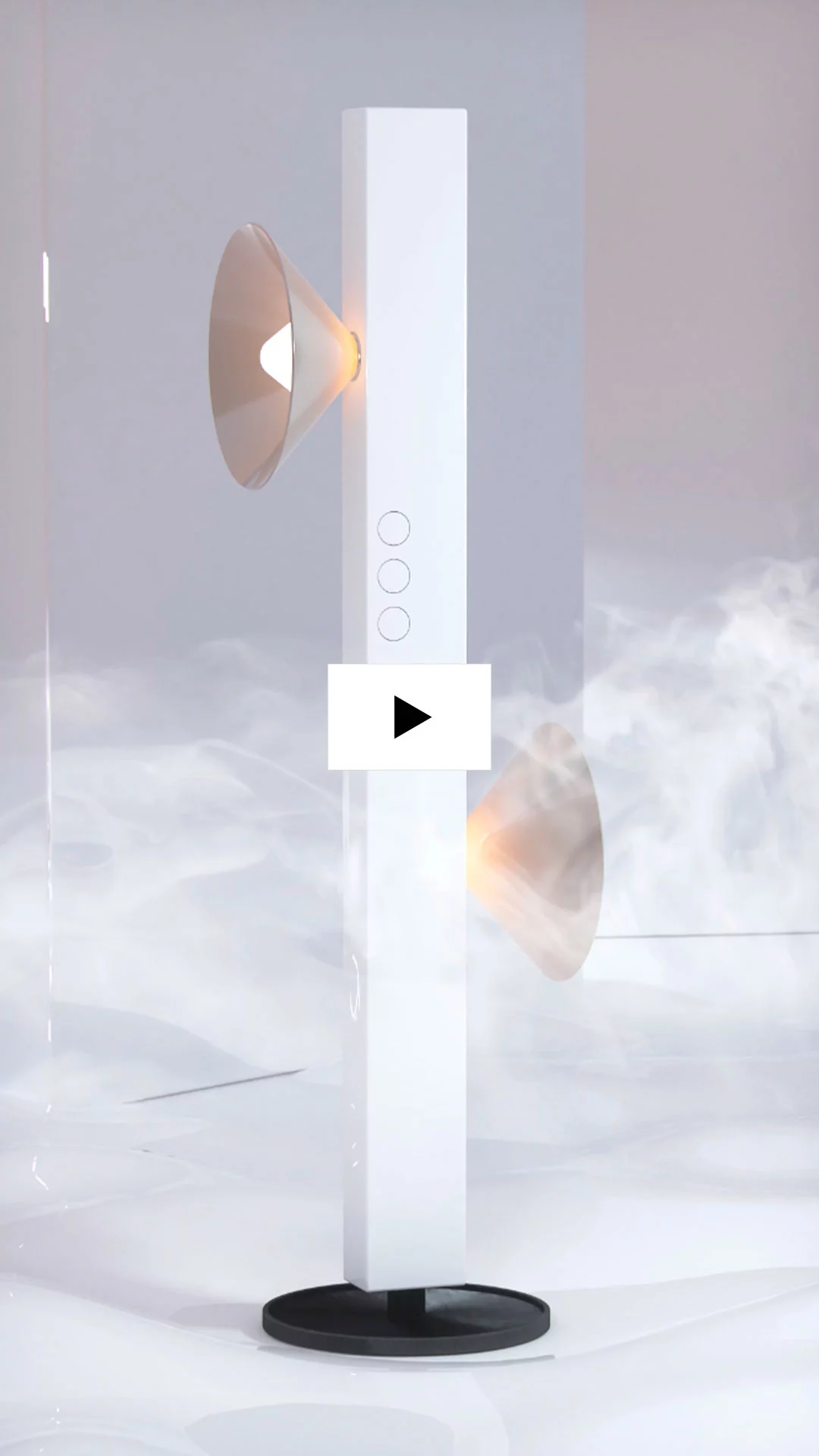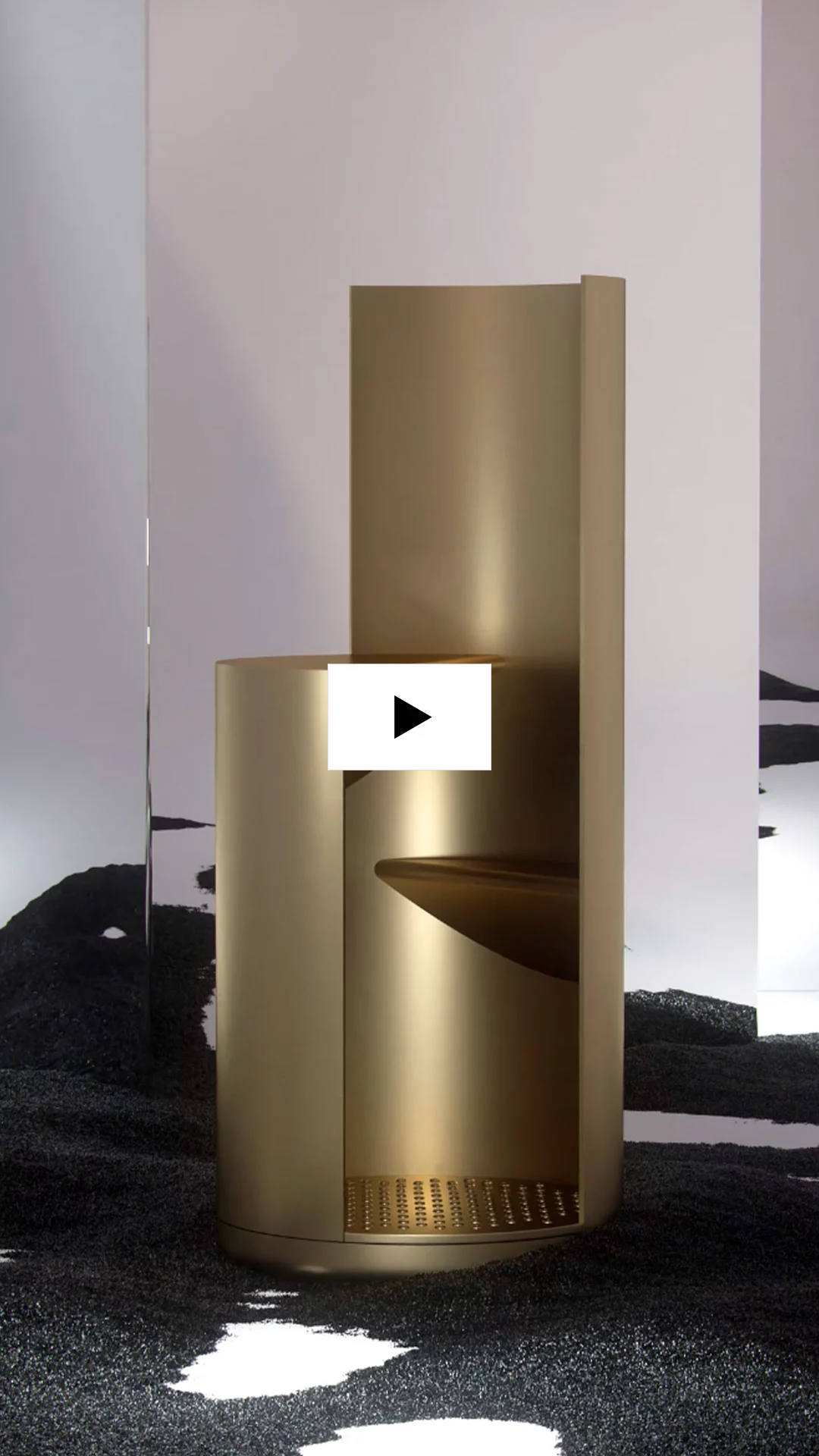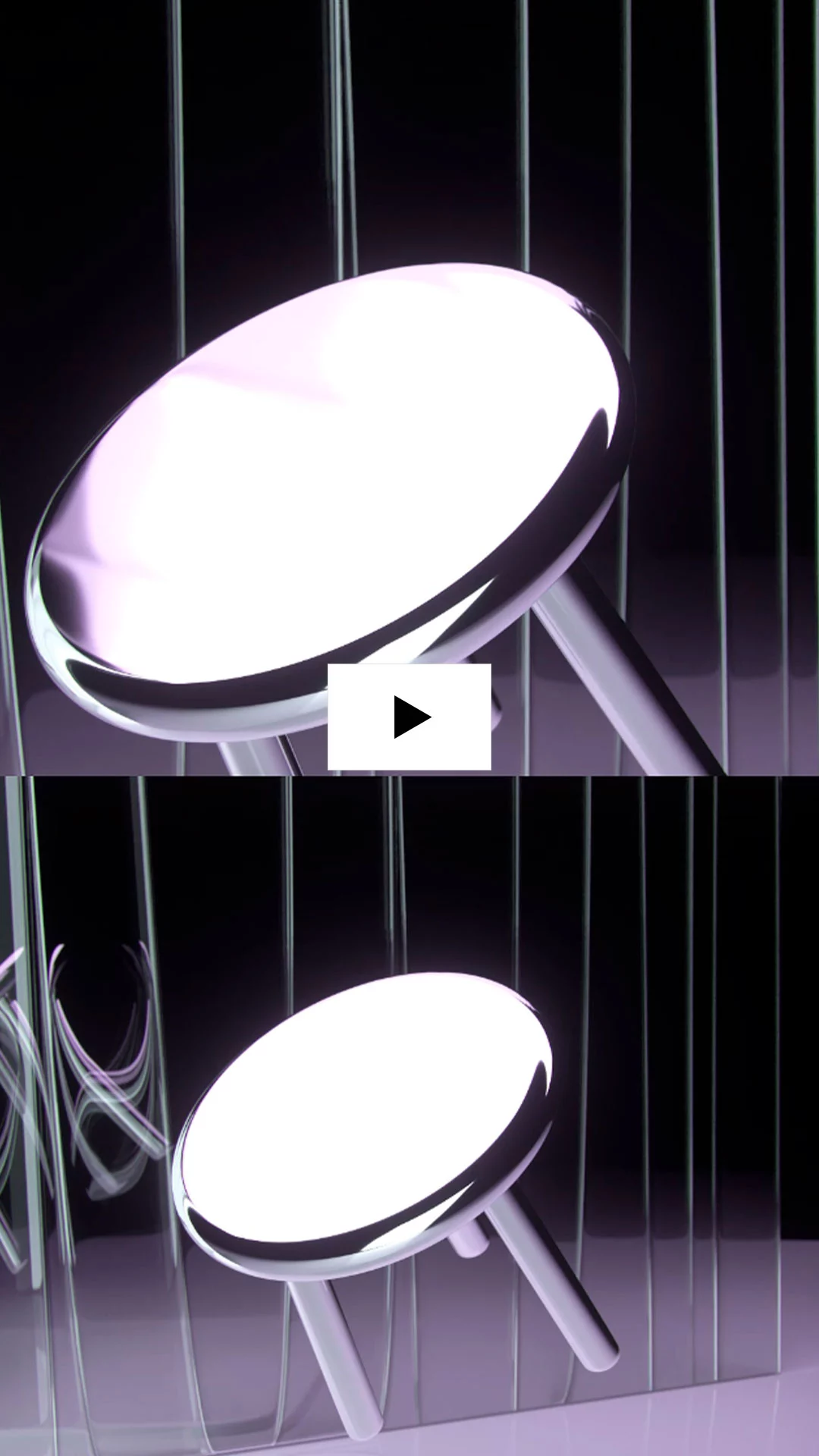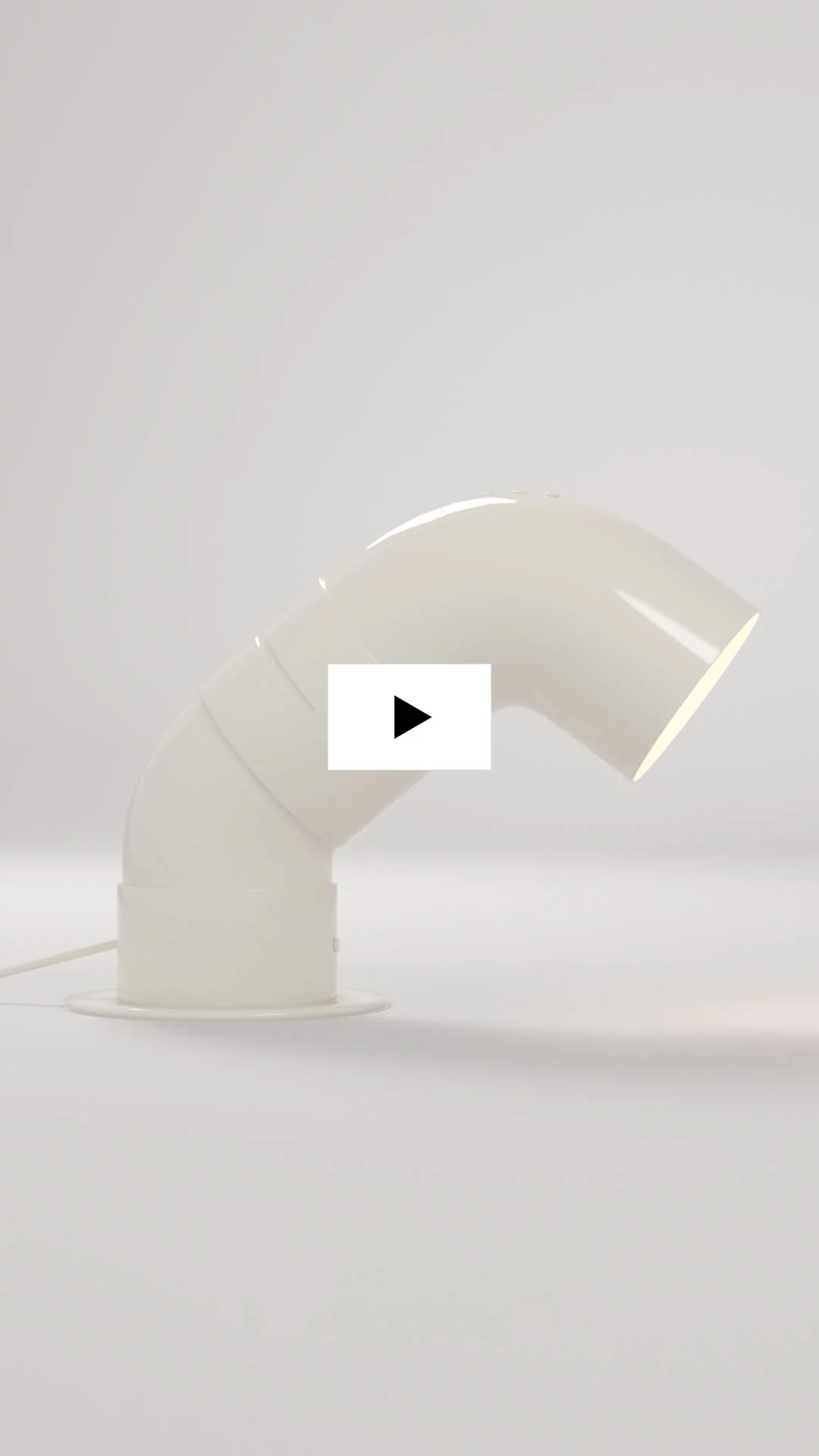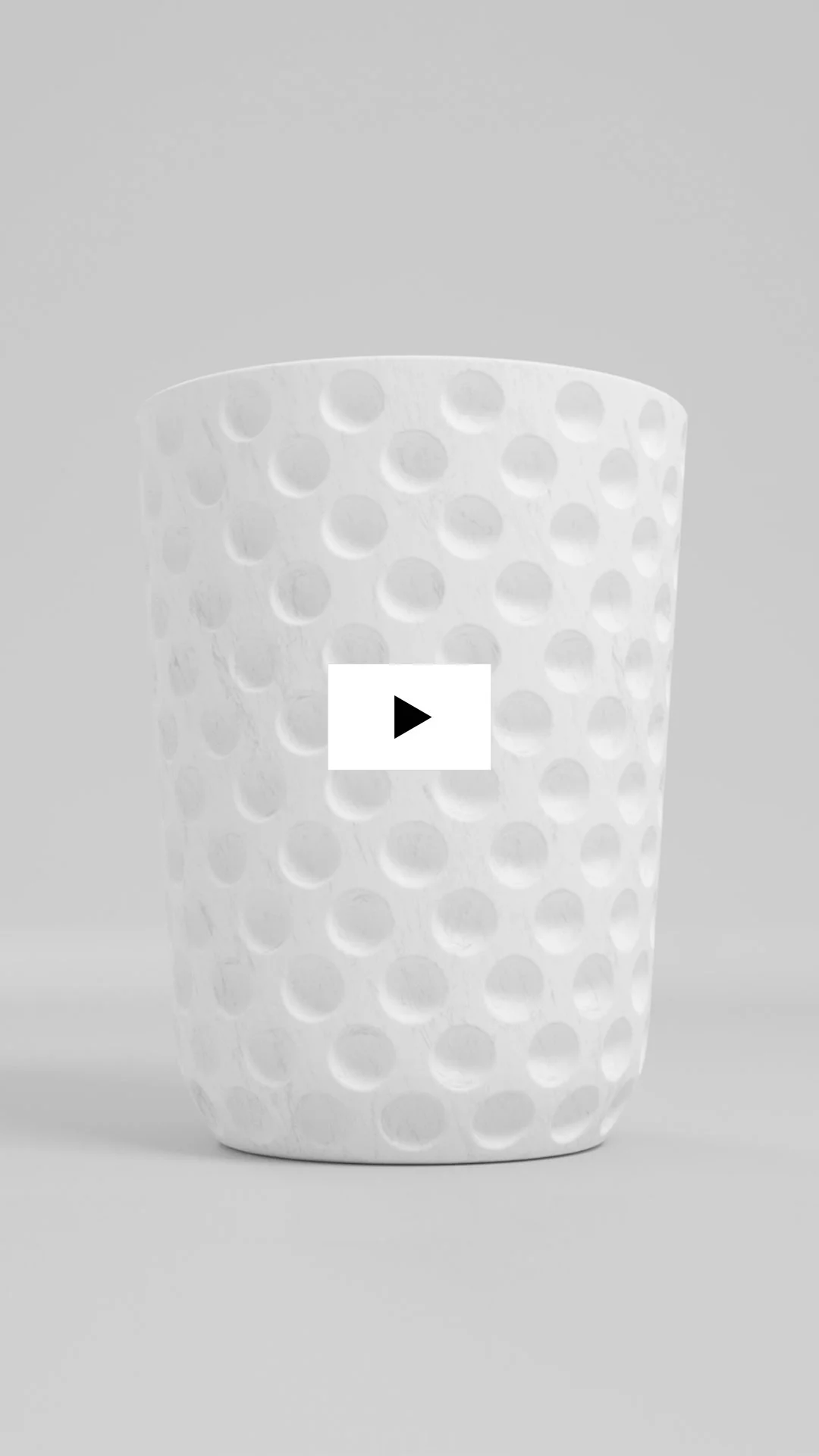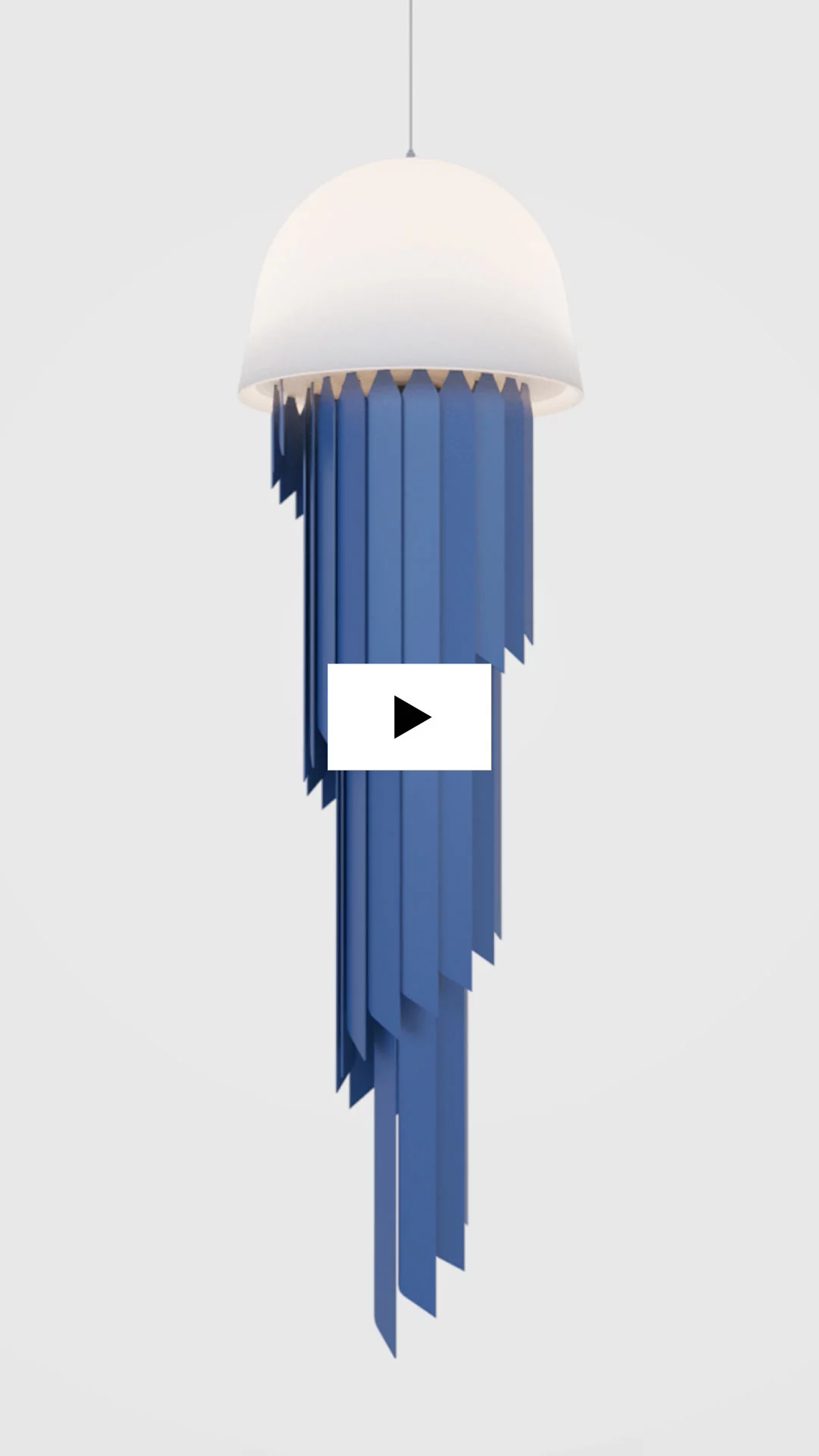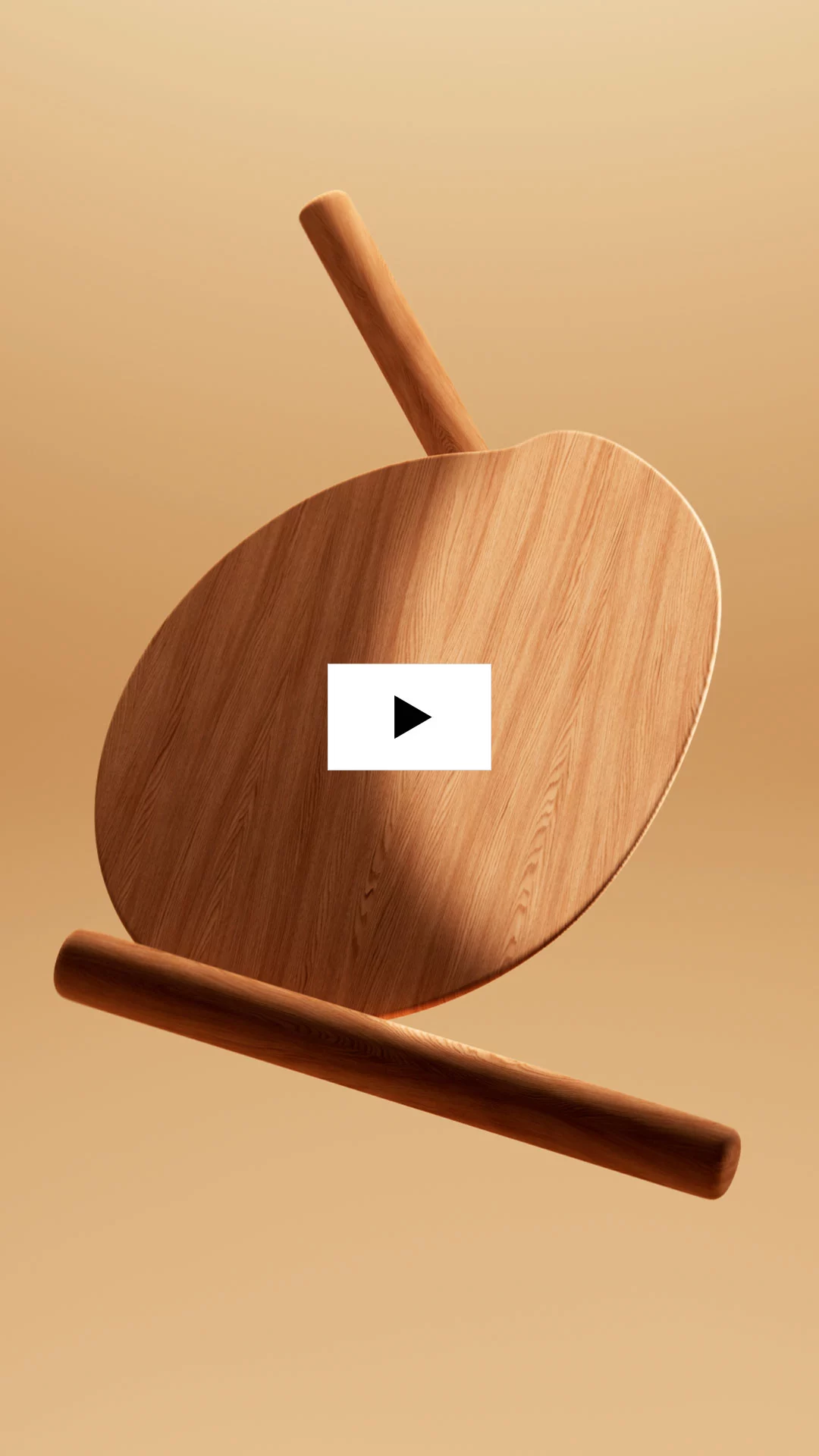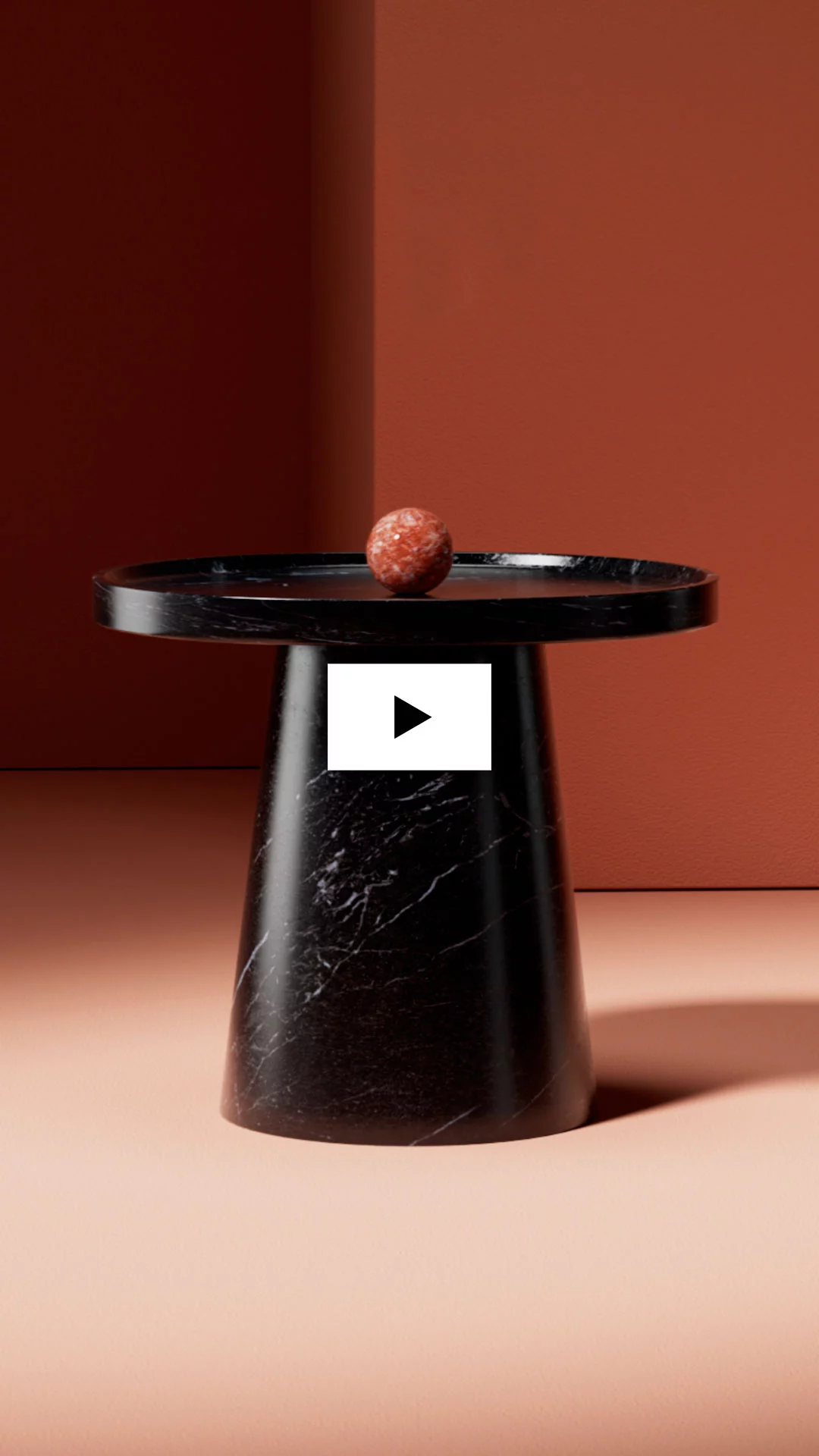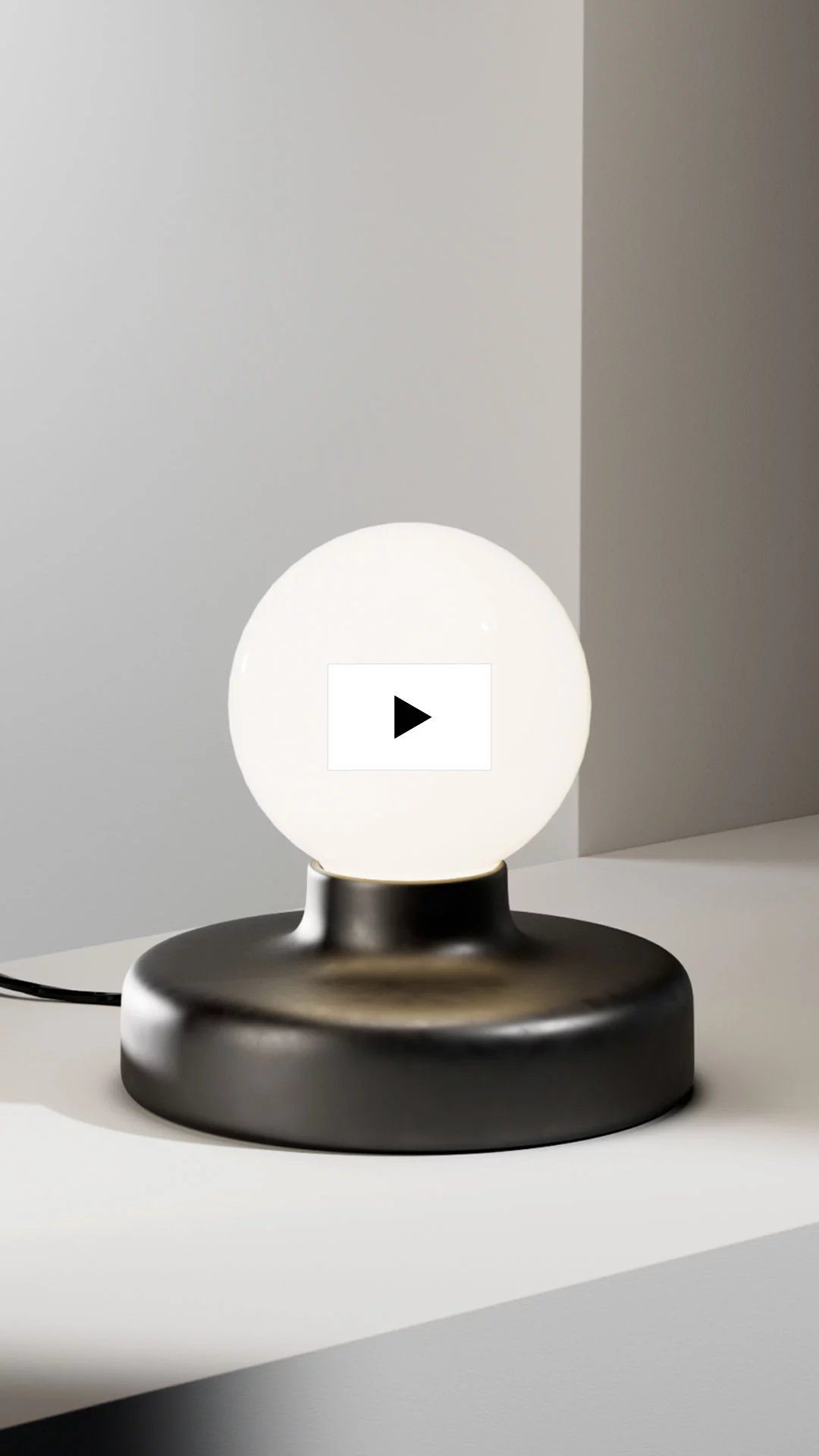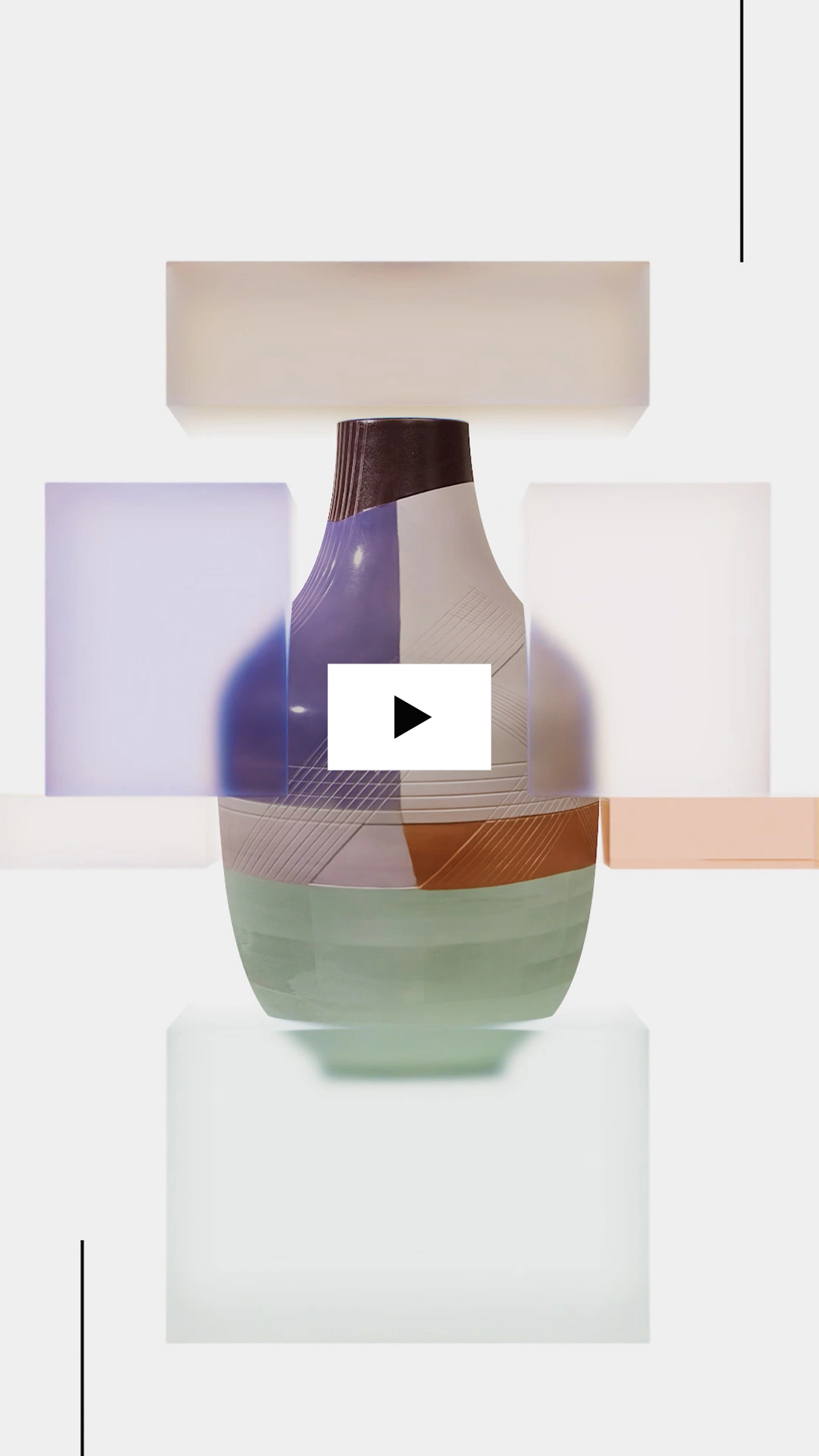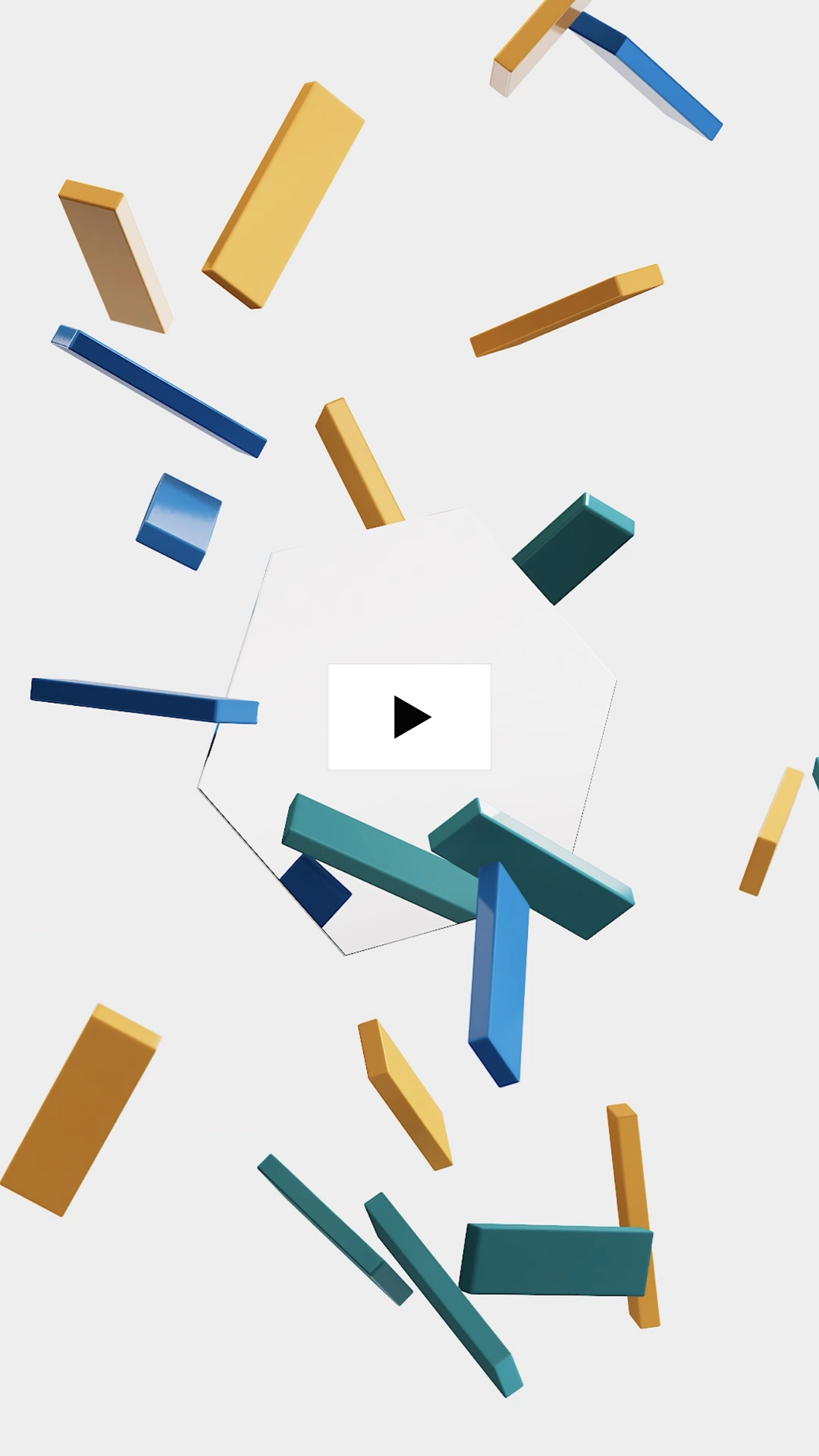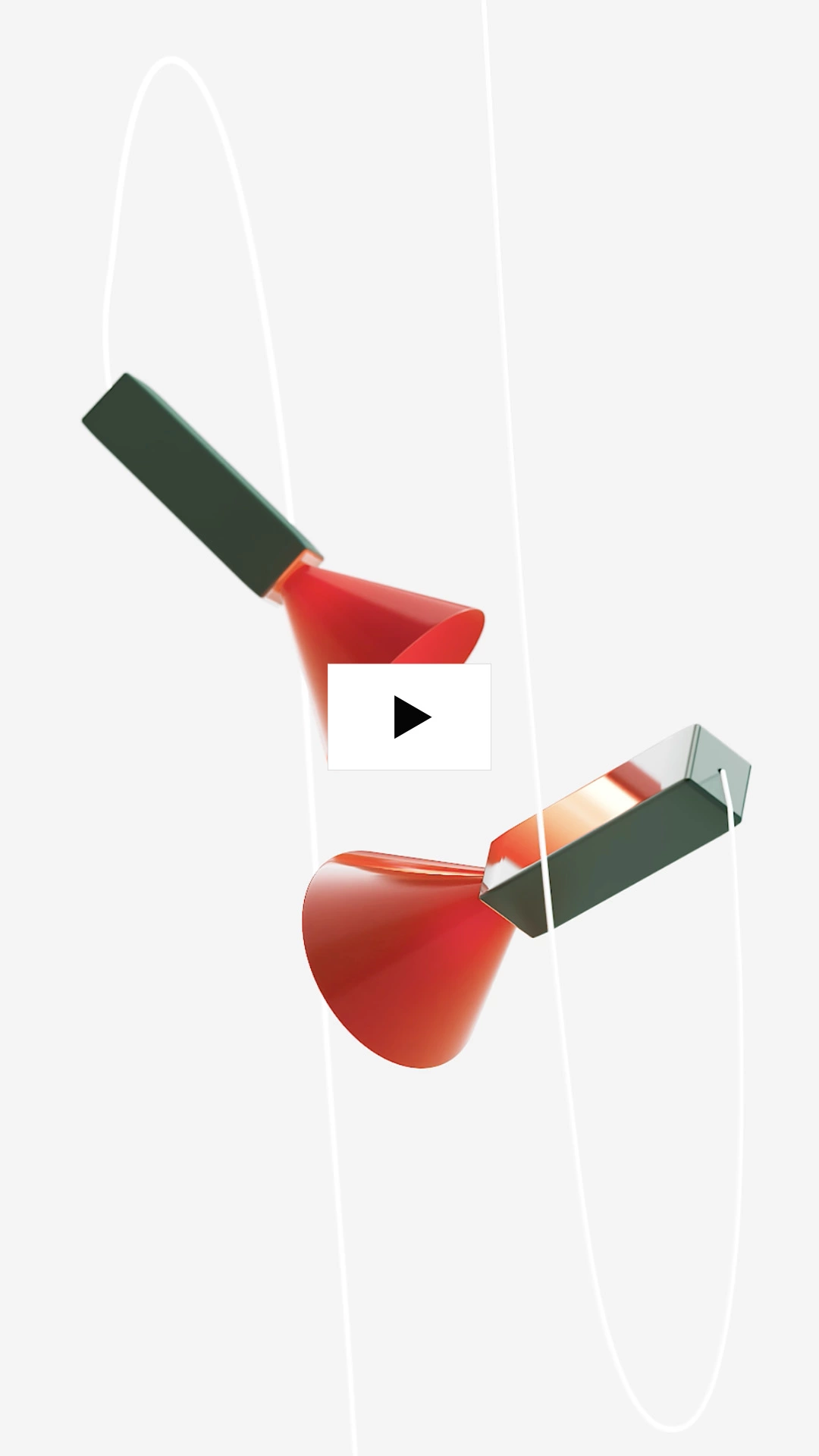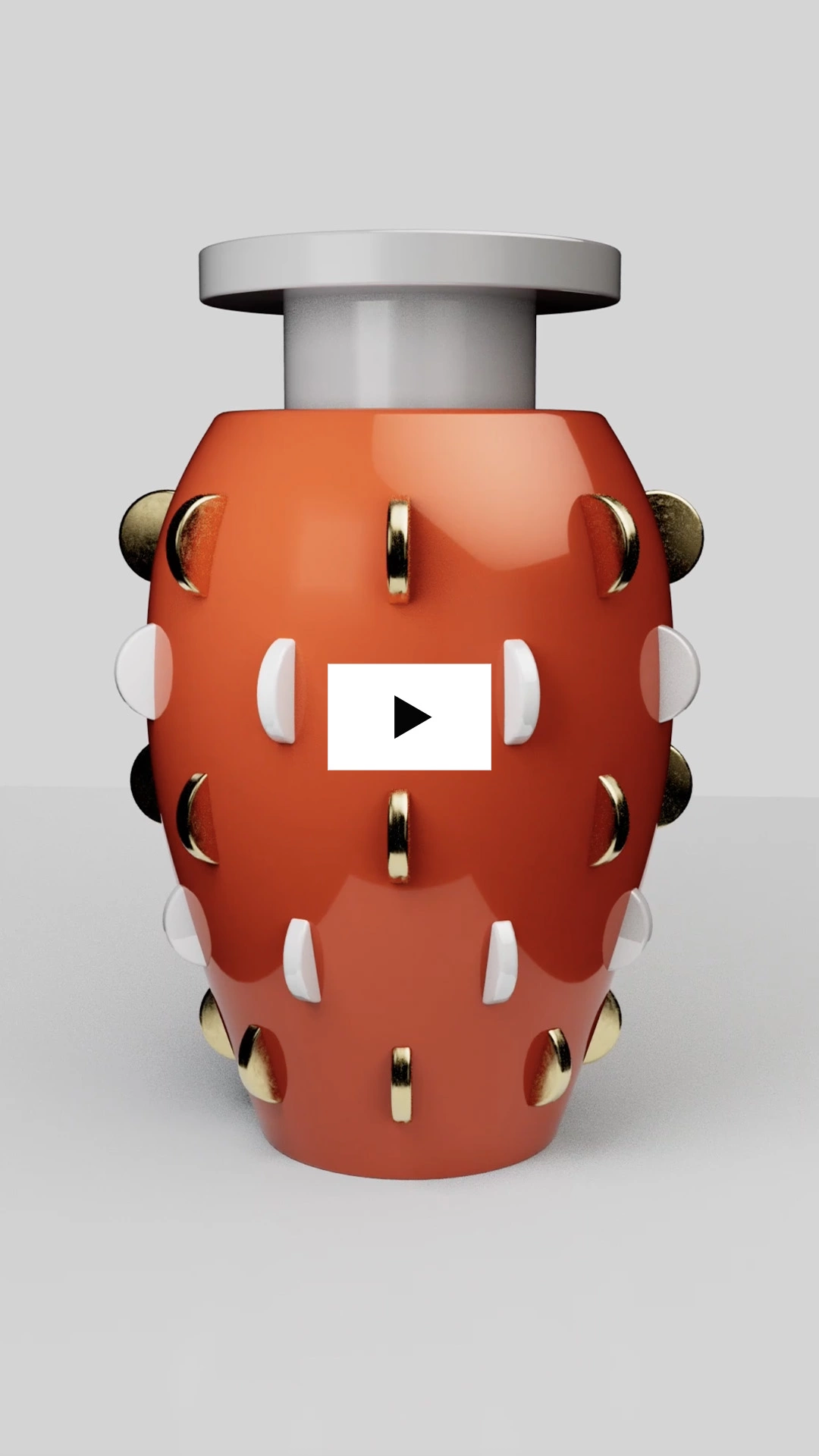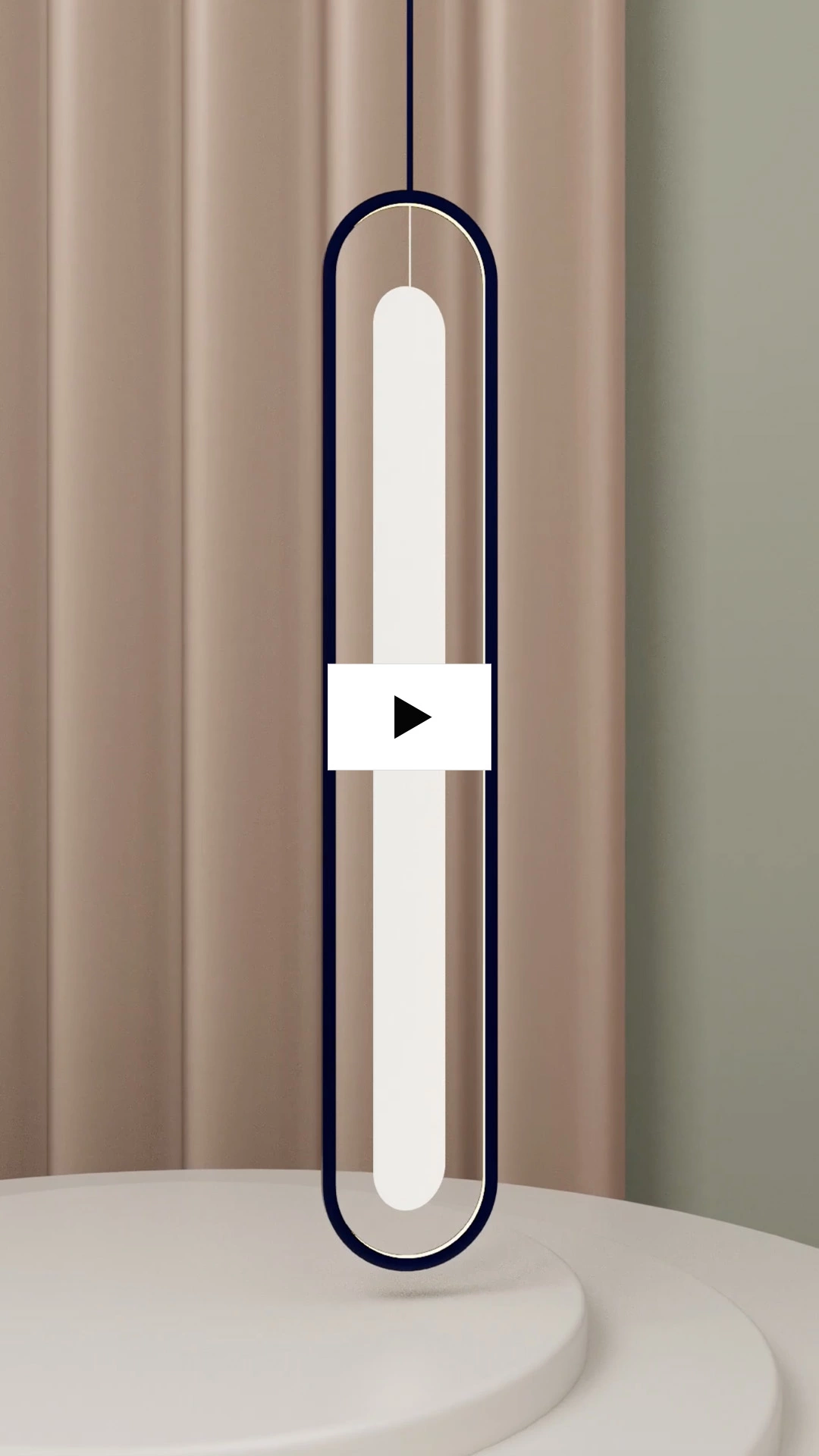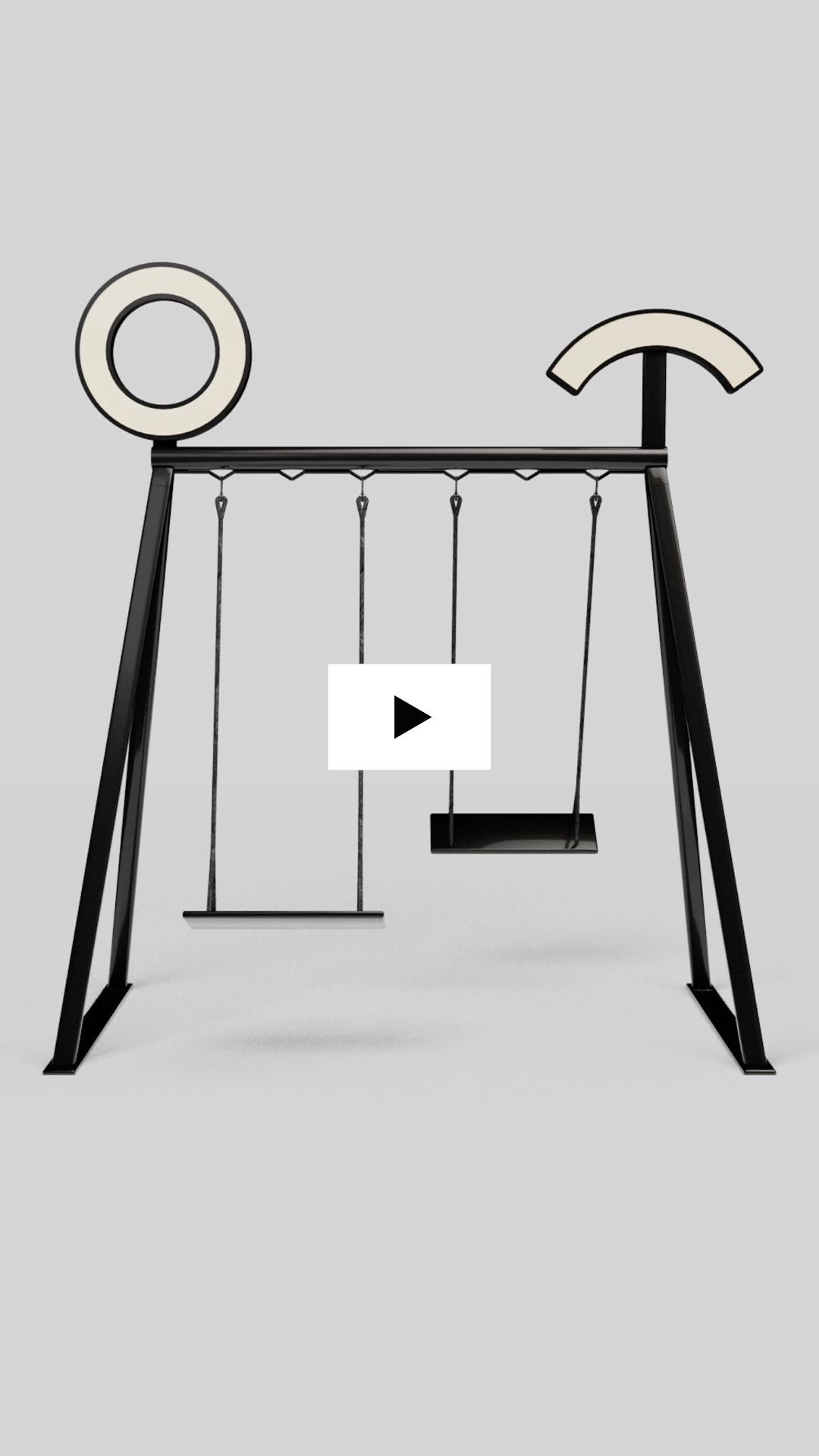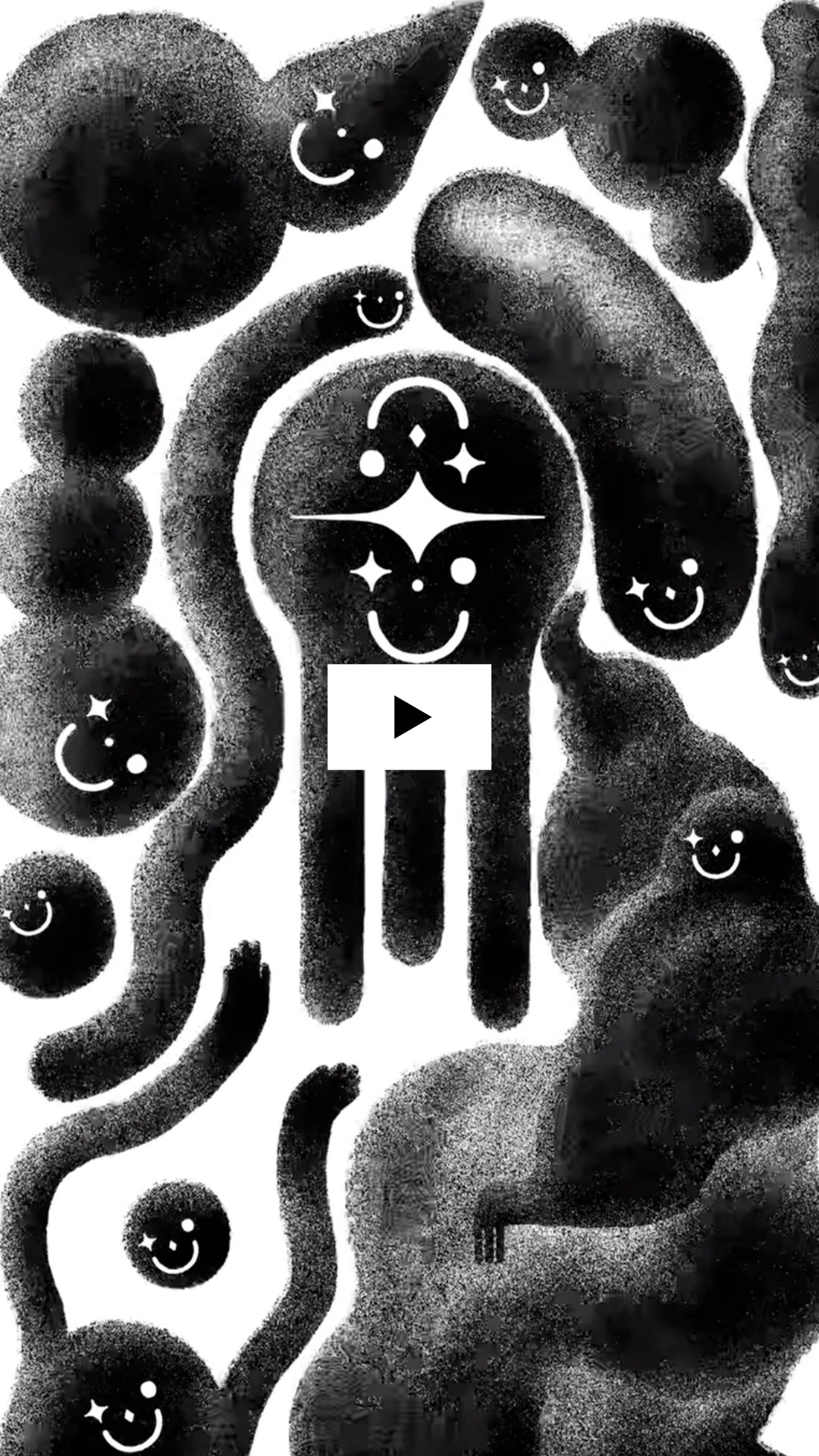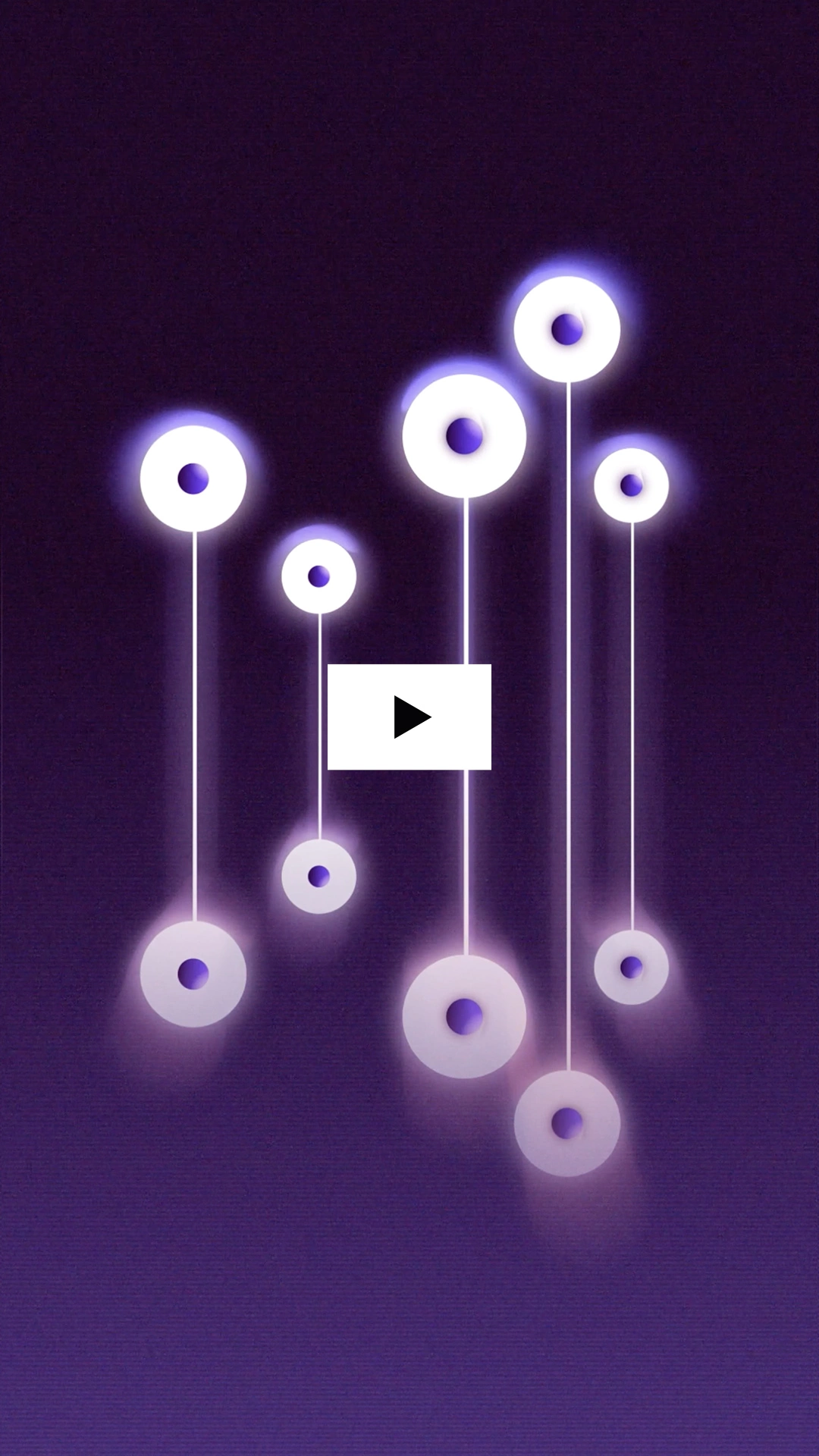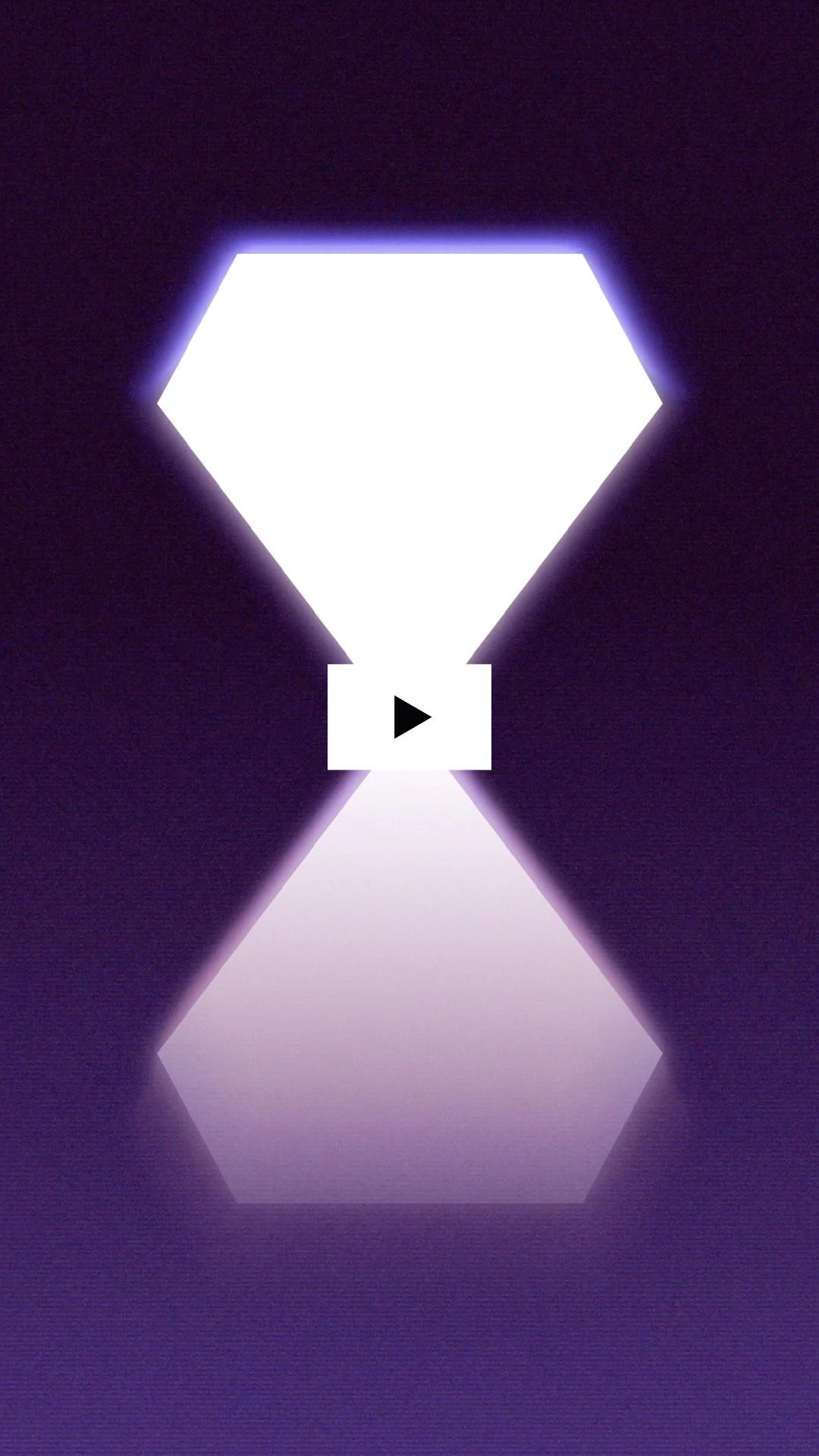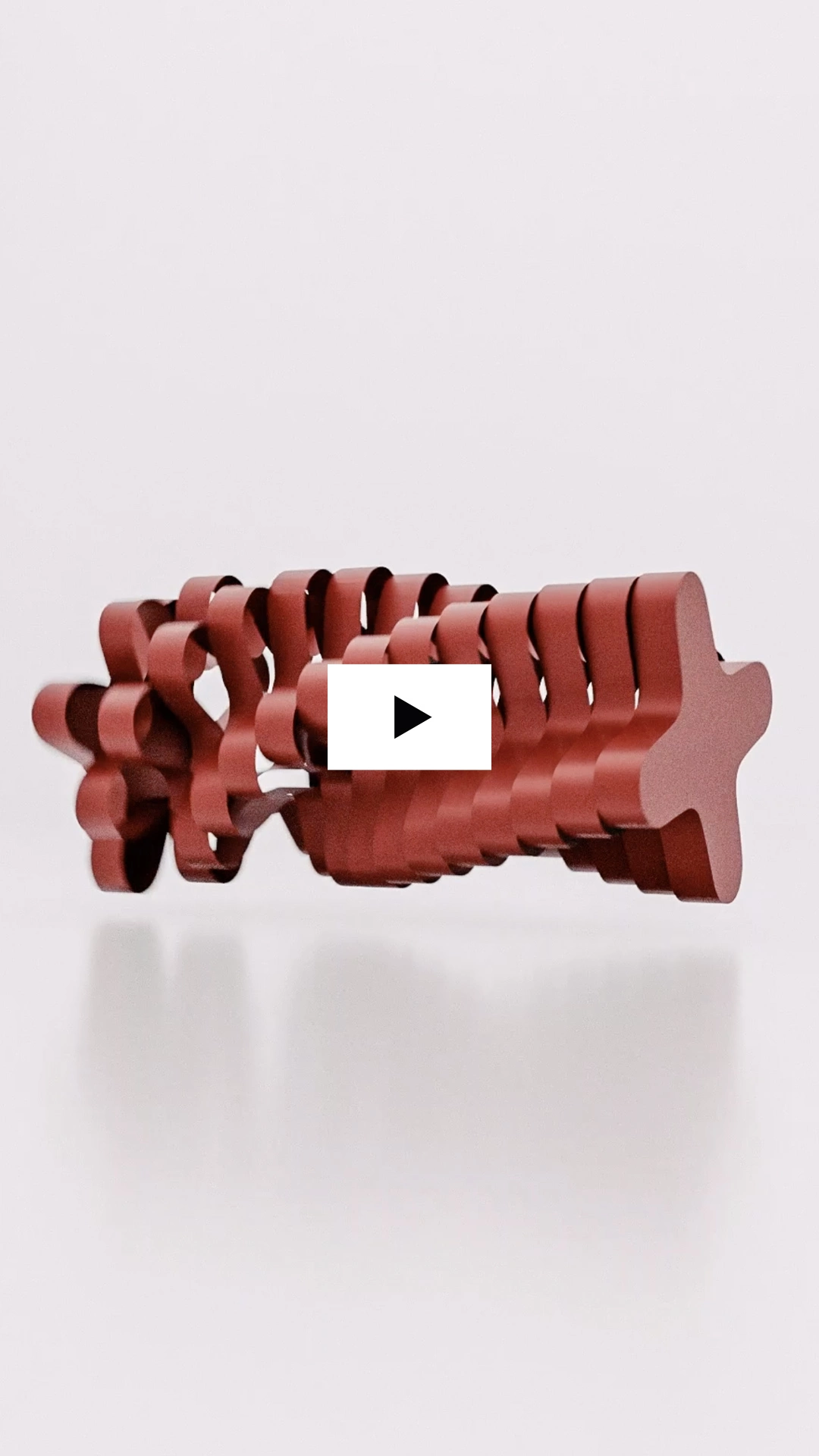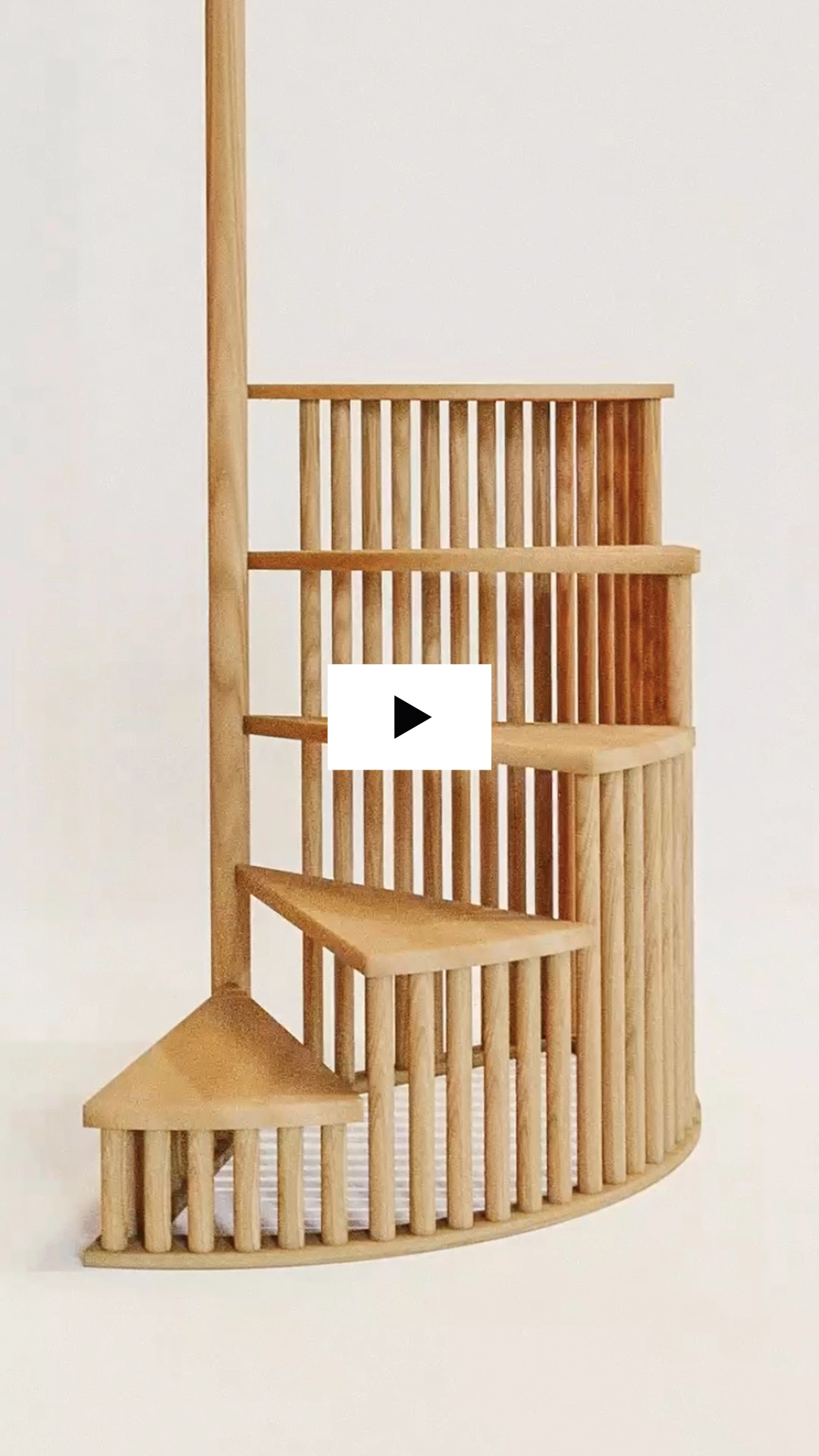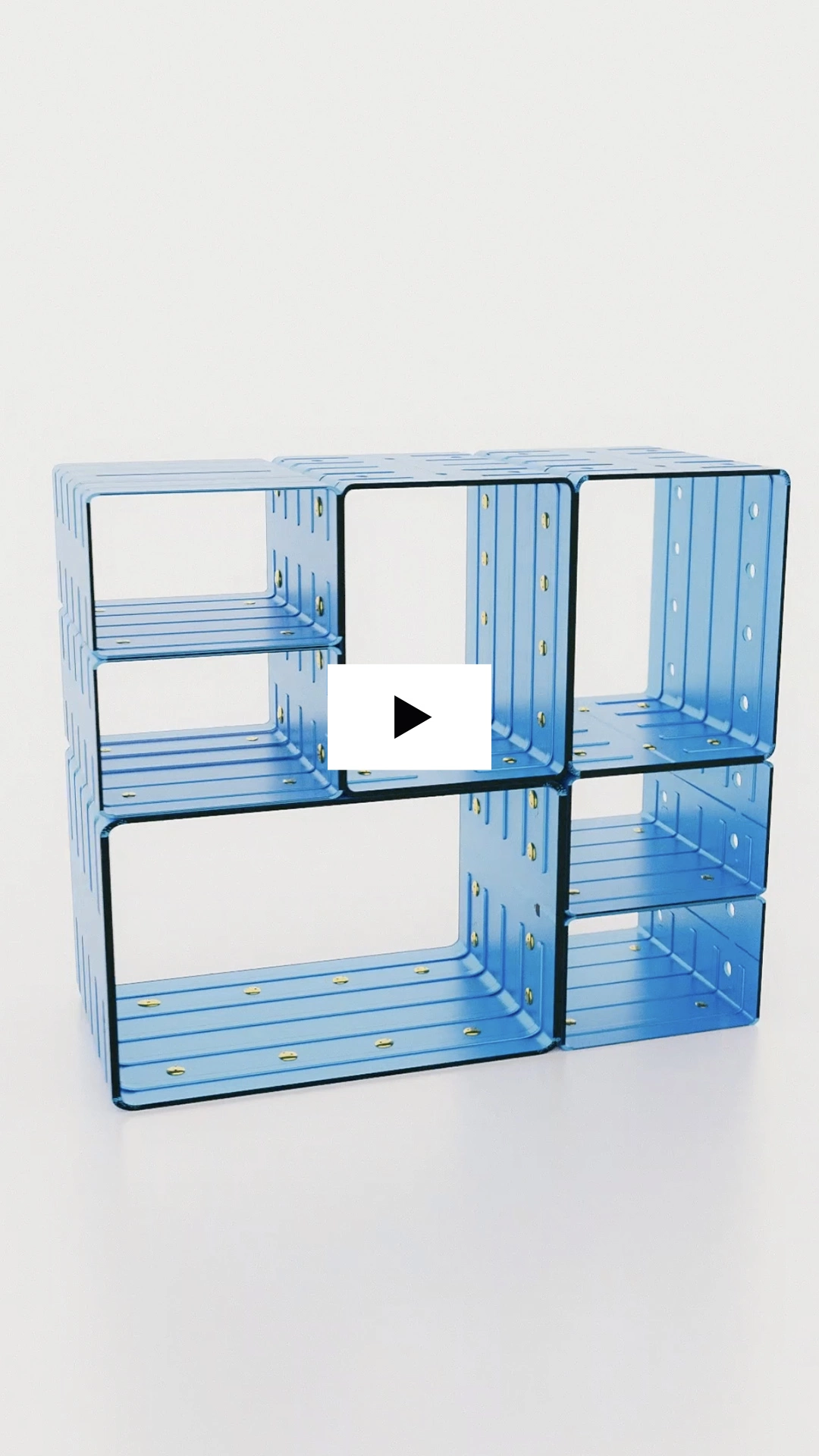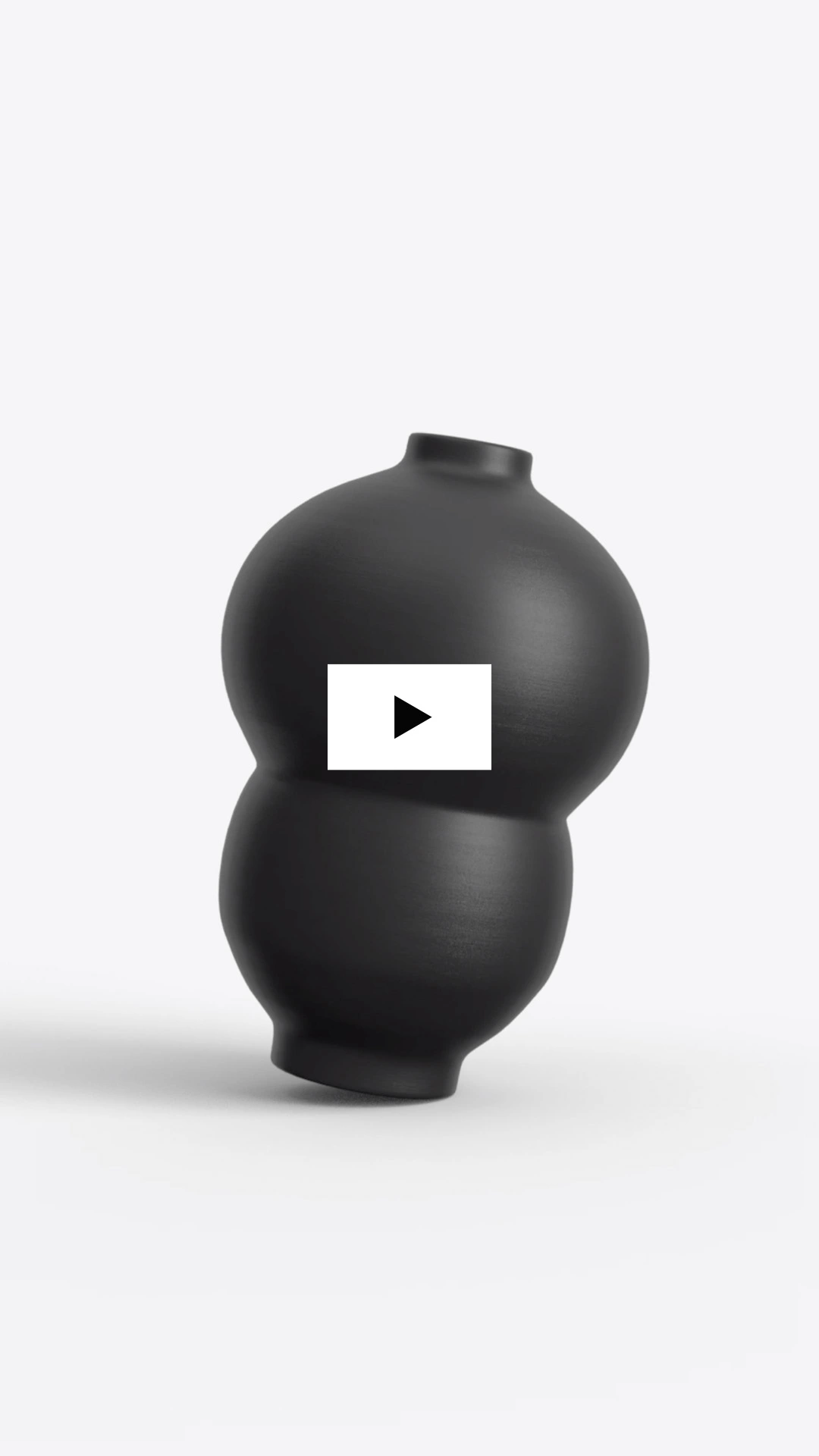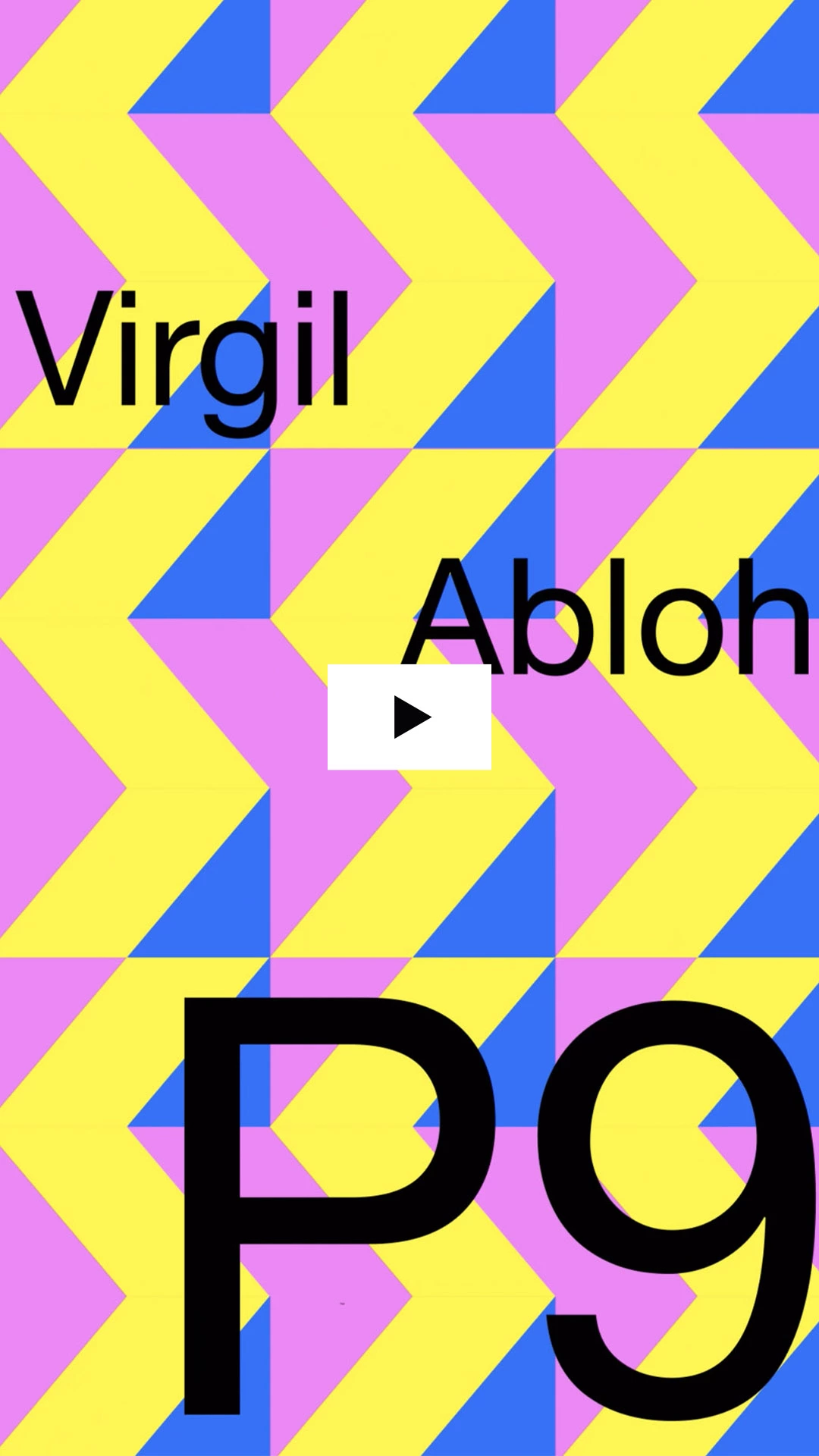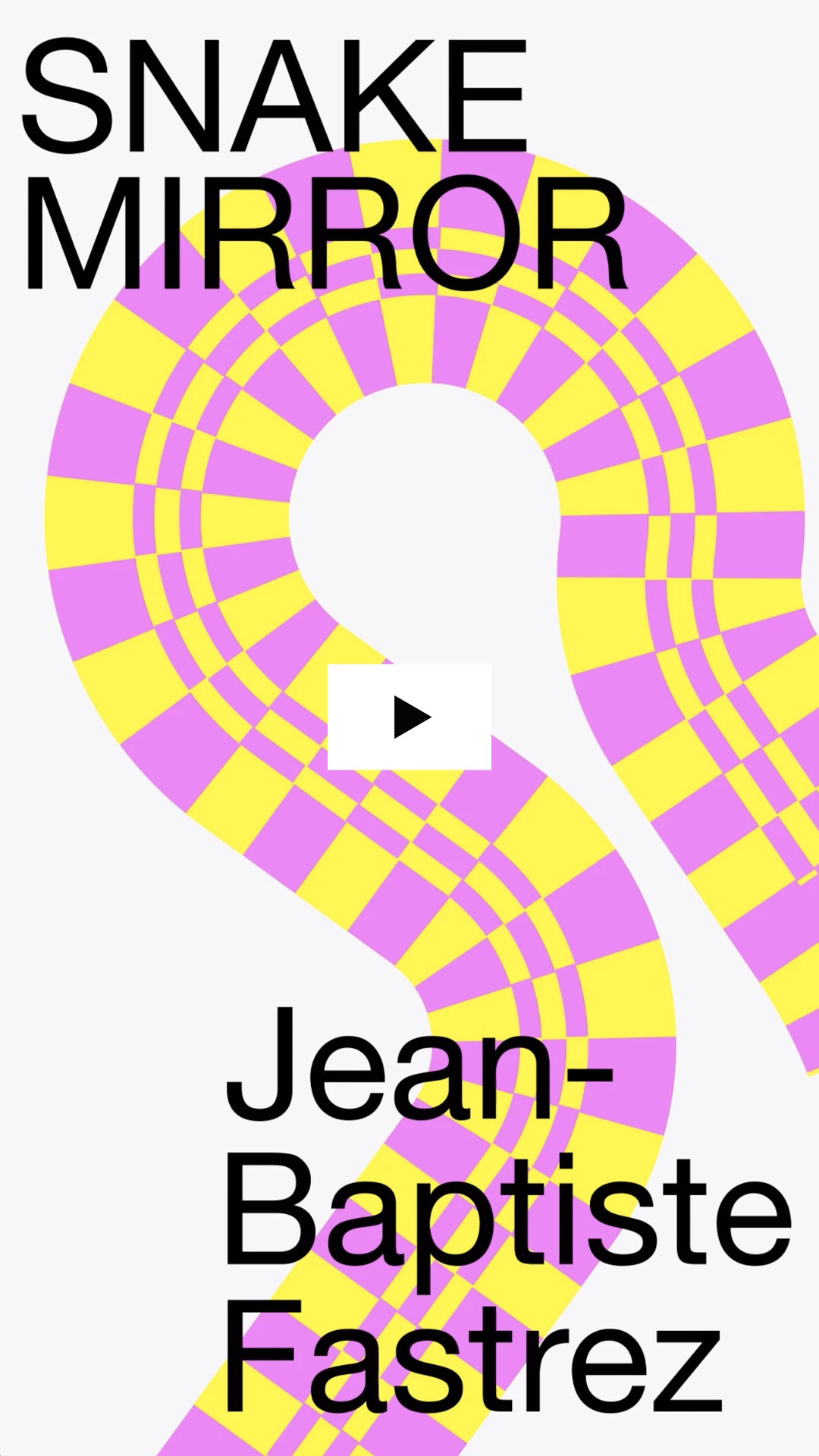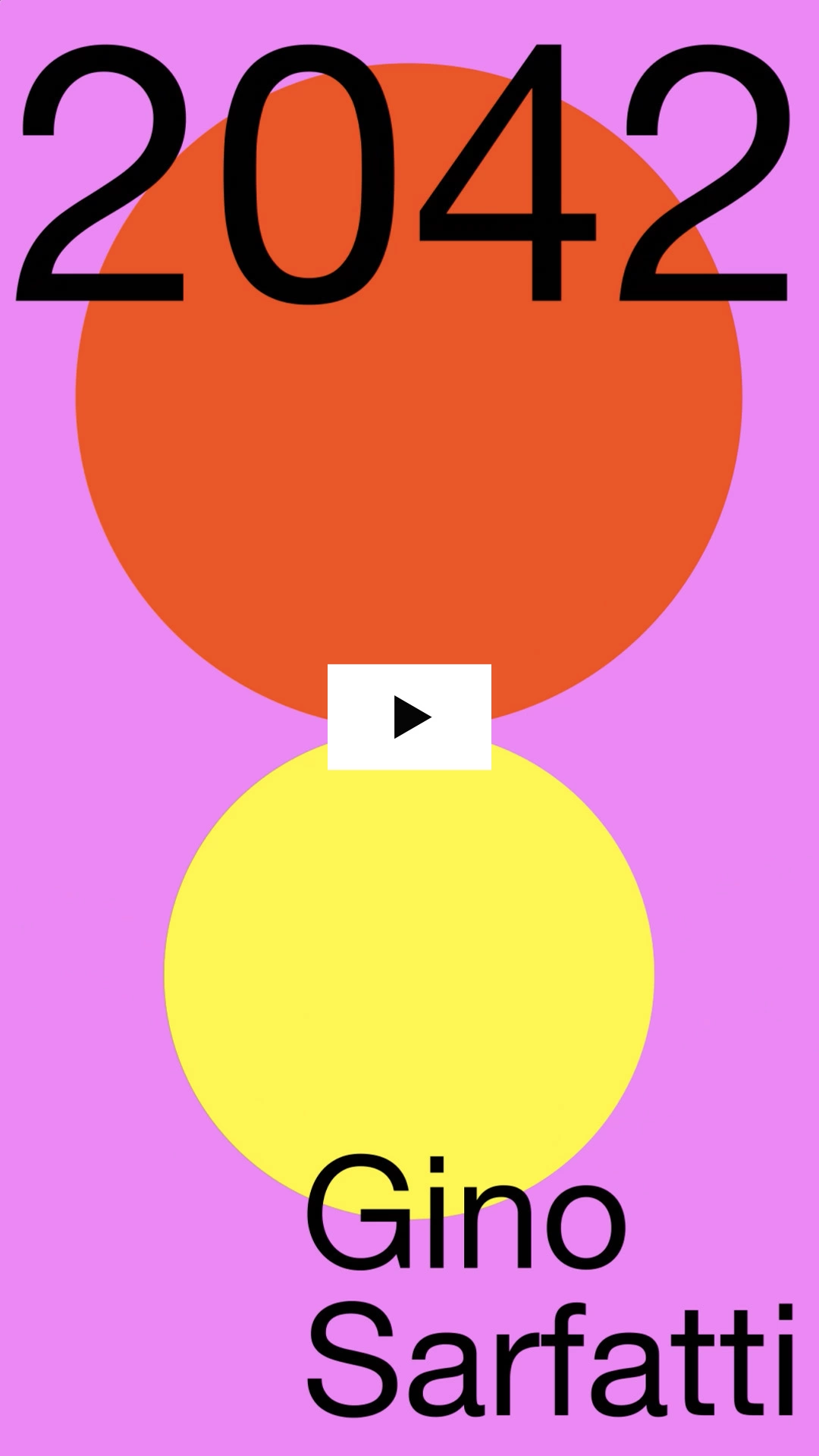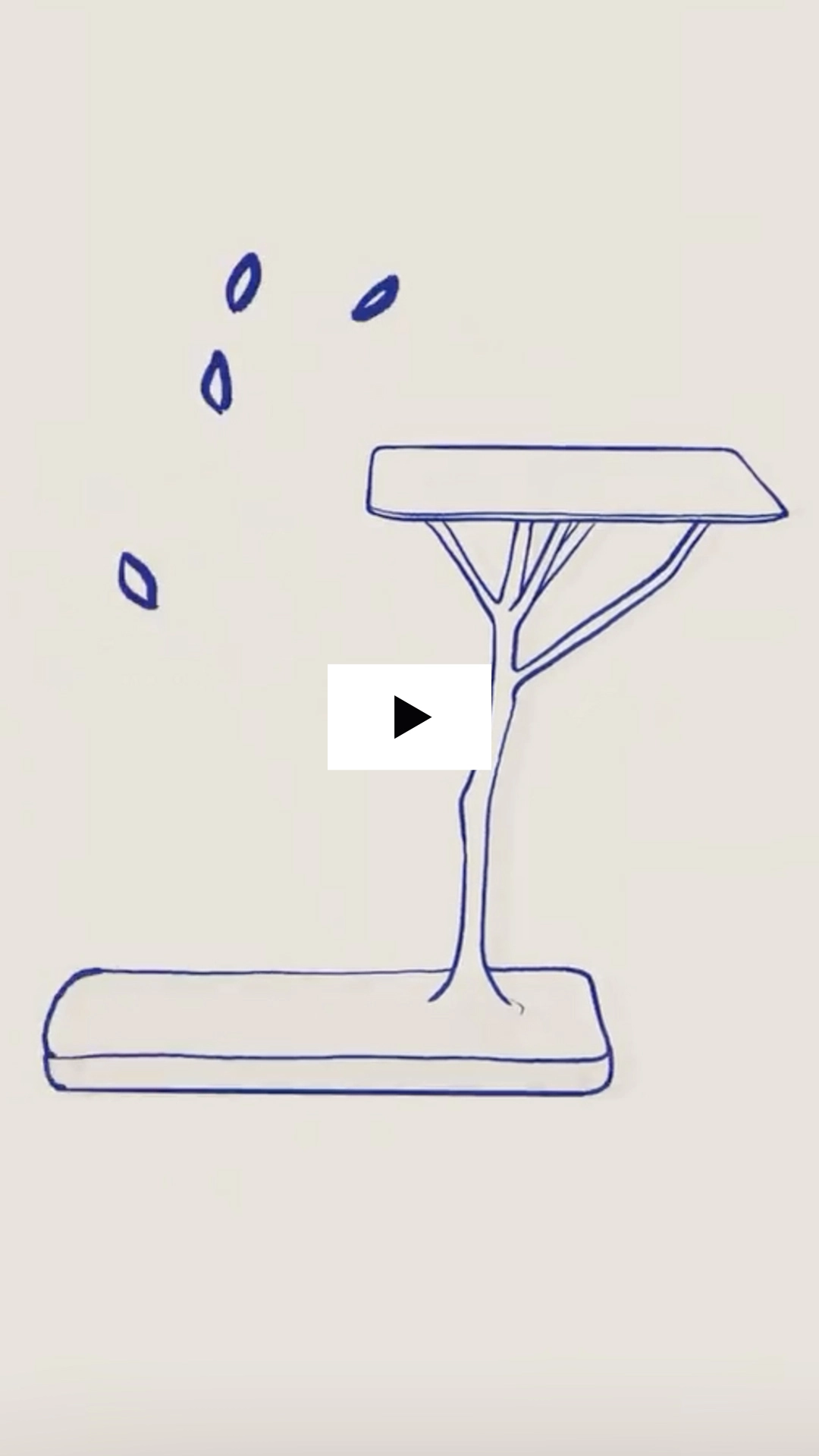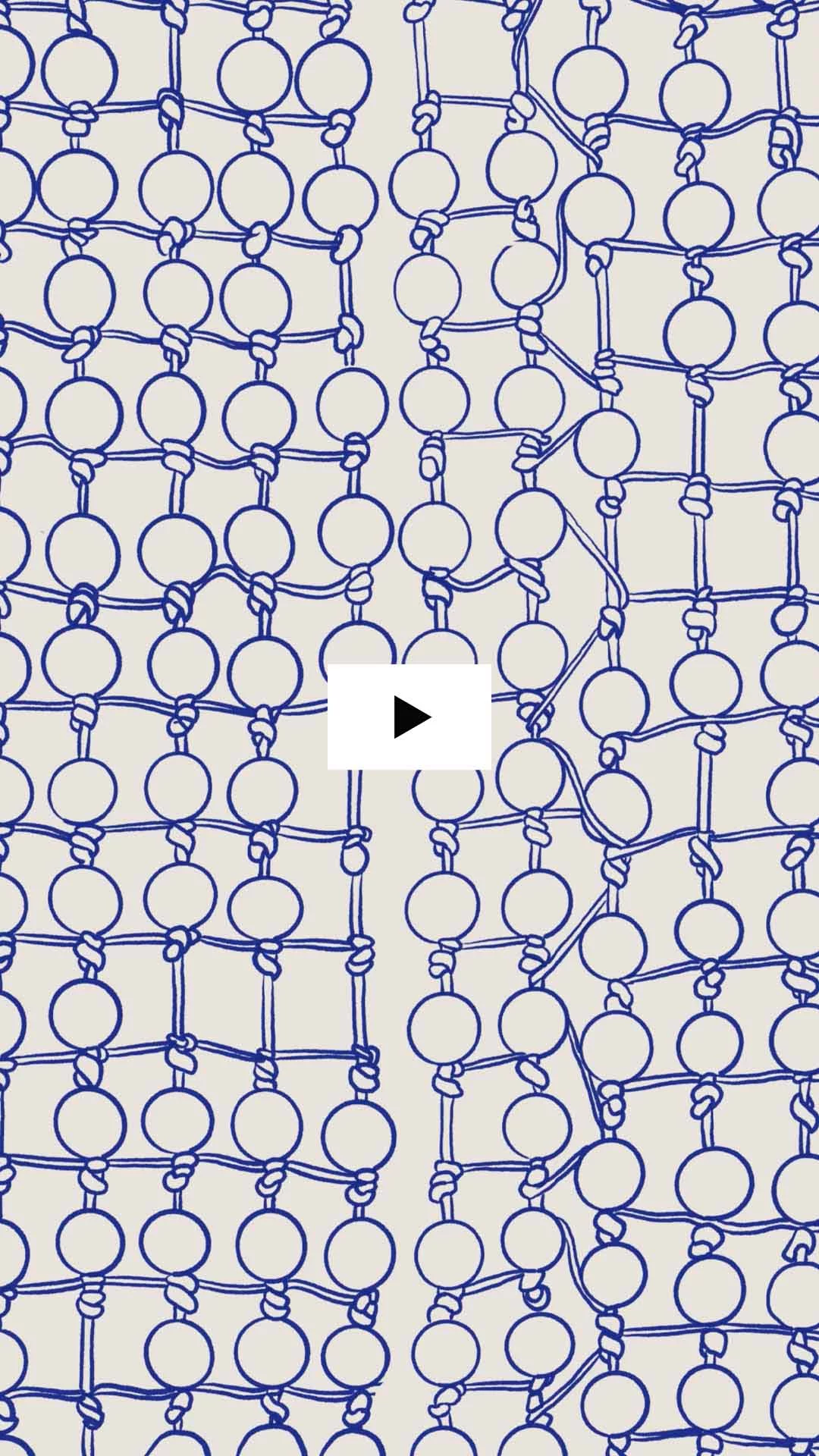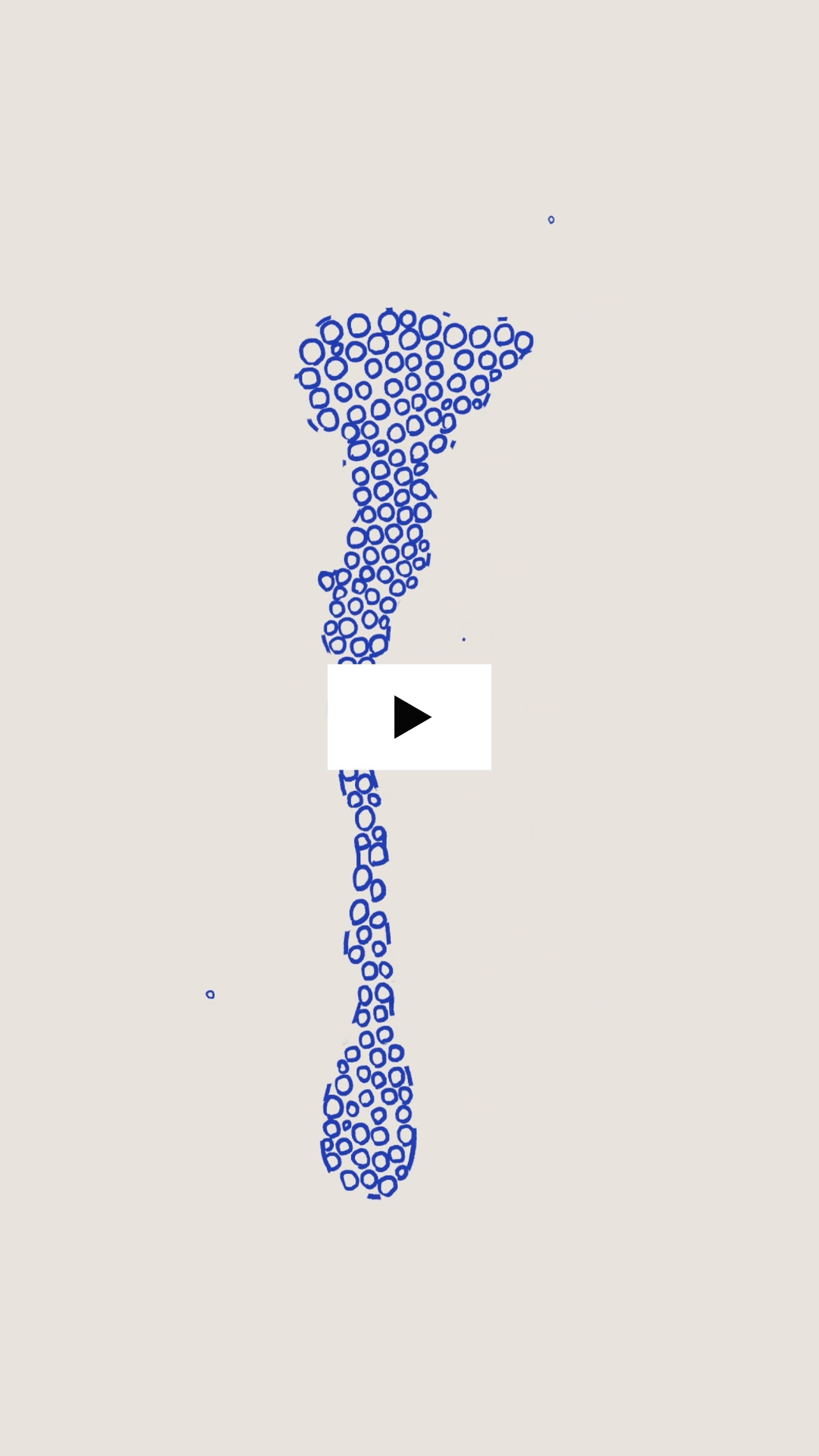Enigma Stool by Lee SeungHak
In Lee’s debut animation, we step into the vibrant world of Alessandro Mendini and his whimsical “Enigma” stool.
Set against a dark monochromatic backdrop, the stool’s bold black and yellow chequered pattern comes to life, resembling the unlocking of a safe. Watch as the stool’s body mechanically disassembles, revealing the imagined interior of the piece, before seamlessly returning to its original form.
Uakari Mirror by Lee SeungHak
For his second animation of the series, Lee has chosen to delve into the distinctive design of Jaime Hayon’s ‘Uakari’ mirror. The mirror, resembling the face of a uakari monkey, intricately captures its features through multiple mirrored sections.
Lee’s animation presents the mirror’s various sections gracefully disassembling and coming together again. The flipping mirrored segments are adorned with pink, red, and orange hues, echoing the vibrant colors of the monkey’s red face.
Lunettes by Lee SeungHak
Discover Lee Seunghak’s third and last animation, featuring Pierre Charpin’s “Lunettes” vase collection. In this new video, Lee brings to life the ‘Lunettes’ vases, where polished aluminum rectangles, resembling eyeglasses, elegantly rotate on their black cylinder bases. The animation, a dance of forms, adds a dynamic layer to the minimalist design, and accentuates the playfulness of the object.
Transformers_LF2 by Basile Fournier
In this animation, Basile brings to life Grcic’s “TRANSFORMERS_LF2” floor lamp. The journey begins by exploring the lamp’s interior, akin to navigating a futuristic tunnel of light. It then unveils the lamp’s silhouette from different perspectives, showcasing the multiple angles of its industrial design. Inspired by the lamp’s construction, which incorporates aluminum jigs commonly used in car manufacturing, Basile’s animation highlights how Grcic exposes the raw beauty of these industrial elements. Each black aluminum jig, adorned with tiny LED spotlights, creates a captivating interplay of light, shadow, and geometry.
Transformers_LS2 by Basile Fournier
In this new animation, Basile sheds light on the large ‘LS2’ chandelier. The video showcases the construction of the piece, seamlessly assembling each aluminium element to reveal the piece’s layered horizontal composition. Bright orange hooks at the top of the chandelier enhance its industrial feel and sense of scale.
Transformers_LS3 by Basile Fournier
Introducing the third animation in Basile Fournier’s captivating series around the world of “TRANSFORMERS” — Konstantin Grcic’s collection of aluminum lamps and tables, inspired by the lighting and car-making industries.
In this animation, Basile focuses on the smallest object from the series: the “LS3” ceiling light. The “LS3” light, composed of multiple aluminum jigs, creates a dynamic and intriguing composition reminiscent of a celestial symphony in space. Basile’s animation offers multiple perspectives on the object, revealing its delicate balance and Tetris-like layout.
Kinari Console by Jakub Dygdón
In Jakub Dygdon's first animation, Doshi Levien’s “Kinari“ console becomes an object of wonder.
Cubes of color fall and balloon into abstract shapes, before aggregating around the rosewood console’s curvaceous drawer in rectangular sections.
The result, highlighting both the console’s sleek design and its beautiful lacquered borders, is a mesmerizing ode to the “Kinari” collection itself, which pays tribute to the borders of the Indian sari, similarly named “kinari“.
Hakone Bench by Jakub Dygdón
Edward Barber and Jay Osgerby’s « Hakone » bench comes to life in a mesmerizing display of wood and movement.
Inspired by the Japanese tradition and its precise joinery, the « Hakone » bench features a sweeping curved top and monolithic legs that evoke the Hakone Shinto Shrine on Lake Ashi. The bench is made of concave and convex forms, generously proportioned and tactile, inviting you to sit and experience its graceful curves.
Jakub’s animation begins with confetti falling from the top of the screen in slow motion; these are revealed to be fragments of wood carved from the bench. Angles of the finished piece then appear, showcasing the intricate joinery and dynamic curves of the bench’s design. The result is a mesmerizing visual interplay that celebrates the « Hakone » bench’s exquisite craftsmanship.
Floor lamp 1654 by Jakub Dygdón
In his final animation, Jakub explores the intricate elements of Robert Mathieu’s ‘1654’ floor lamp. The lamp, crafted with finesse and pure lines, features a black metal base and three lacquered lampshades in typical 1950s colors.
Starting as separate elements, the object’s stems and shades gradually come together as a cohesive whole, offering a new perspective on Mathieu’s iconic design.
Ignotus Nomen Shelf by TP Vineeth
TP Vineeth’s second animation puts François Bauchet’s Azo table in perspective: its immaculate tabletop very simply laid atop its single X-shaped leg.
In the Azo collection, François Bauchet explores the possibilities of hybrid materials, and their effect on essential colours. Here, the table, made of concrete, resin and sand, takes on an organic form, which is reflected by the subtle graining across its white surface.
Azo-x Round Table by TP Vineeth
TP Vineeth’s second animation puts François Bauchet’s Azo table in perspective: its immaculate tabletop very simply laid atop its single X-shaped leg.
In the Azo collection, François Bauchet explores the possibilities of hybrid materials, and their effect on essential colours. Here, the table, made of concrete, resin and sand, takes on an organic form, which is reflected by the subtle graining across its white surface.
n.28 Oggetti lenti Serie by TP Vineeth
For her last animation, TP Vineeth looks at Pierre Charpin’s table light no. 28, from his ‘Oggetti Lenti’ (slow objects) series.
‘I have designed a collection of vases, lamps, boxes, centrepieces […] that are less well defined’, Charpin said of this series. Table light no. 28 typifies this statement, as it takes on a hybrid appearance, combining all mentioned typologies into a single object.
Signal F2 Monochromatic by Jens Mennicke
With Jens Mennicke’s first animation, looking at Edward Barber and Jay Osgerby’s ‘Signal F2 Monochromatic’ floor light.
In this animation, Jens plays with the lamp’s two ashy conical shades, as these move up and down its white, glossy structure. A nebulous fog surrounds the object as if to emphasise its mysterious presence.
Hieronymus Metal by Jens Mennicke
In this new animation, Jens sets Konstantin Grcic’s metallic ‘Hieronymus’ in a shimmering black desert - as if echoing the object’s otherworldly nature.
Indeed, in his ‘Hieronymus’ collection Grcic asks us to reconsider our relationship to space: what makes a space intimate, pleasant or conducive to study? Here, Jens takes these reflections a step further by bringing Grcic’s hybrid seating-object in a space devoid of indications of space and time; as a result, one must imagine their own context for ‘Hieronymus’.
3-legged stool by Jens Mennicke
In Jens Mennicke’s third and final kreo in motion animation, Jasper Morrison’s emblematic stool forms from flowing drops of metallic liquid, into a solid three-legged structure.
Morrison’s piece, materialising the archetypal form of the stool, is an exercise in simplicity. With ingenious mirror plays and rhythmic tones, Mennicke’s brings light to its essential design, deconstructing and constructing it in turn.
602 by Kirill Pyrev
To start off the series, Kirill has picked Cini Boeri’s beautiful table light from 1968.
This retro-futuristic ‘602’ model was designed by Boeri, and produced by Gino Sarfatti’s light company Arteluce.
Its main body, made of rigid industrial PVC piping, includes a system that allows the main arm to pivot.
Kirill’s animation highlights the lamp’s slowly evolving body, as well as its unctuous finish.
Game On Side Table by Kirill Pyrev
Playfulness is at the centre of Kirill’s second animation, as the motion designer composes a delightful image of Jaime Hayon’s equally playful ‘Game On’ side table, with a lively and rhythmic tune.
In this animation, Kirill deconstructs an imaginary slab of marble to reveal Jaime Hayon’s patterned side table, composed of Carrara white marble.
The repetition of the circular geometric pattern all along the table creates a striking contrast with the natural veins of the marble.
Jellyfish by Jean-Baptiste Fastrez
Up and down go the blue tentacles of Jean-Baptiste Fastrez’s ‘Jellyfish’ chandelier in Kirill’s last animation.
Fastrez’s ‘Jellyfish’ light, composed of a white polycarbonate lampshade and blue anodised aluminium pendants, suggests the shape of the eponymous water creature, whose umbrella-shaped bell here has swapped its natural luminescence for an electric light, running down the sides of geometric metallic tentacles.
With a dreamy sound to accompany the motions of the marine animal, Kirill proposes a wondrous last animation to close his participation to the kreo in motion series.
SDOOW4L Desk by Marco Serraca
In this first animation, Marco Serraca sets Jasper Morrison’s ‘SDOOW4L’ desk against an atmospheric nude background, drawing attention to the piece’s simple construction and polished contours.
M.C Side Table by Marco Serraca
Marco Serraca’s second animation interprets Pierre Charpin’s ‘MC Side Table’ — a generously curved Marquinia black marble structure playfully adorned with a Rosso Francia marble ball.
In the animation, Marco sees the red ball rolling to its elevated counterpart, resulting in a beautiful two-coloured marble composition.
608 by Marco Serraca
In his third and last animation, Marco Serraca brings life to Gino Sarfatti’s ‘608’ table lamp from 1971.
Playing on the minimal and essential design of the desk lamp — made up of a black base and a large, frosted light bulb — Marco pays tribute to the Italian master’s ingenuity, still an important source of influence for designers of today.
Facet Bottle — Day by Roy Veldkamp
Roy Veldkamp re-imagines Hella Jongerius — Day’ ‘Facet Bottle’ as light-diffused molding blocks slowly falling into place.
The blocks create a facetted surface pattern on the object, just like Hella’s paint crosses over different textures of the ceramic vase.
Mini Satellite 3 by Roy Veldkamp
Roy Veldkamp's second animation focusing on Pierre Charpin’s ‘Satellite’ mirror.
Forming part of Charpin’s eponymous collection of polygon mirrors, the present piece boasts a triangular reflective surface bordered by three honey-yellow frames.
With his cadenced animation of floating satellites orbiting around the centrepiece, Roy enhances the playful and rhythmic dialogue between the mirror and the colourful frames.
Signal C1 polychromatic by Roy Veldkamp
Roy Veldkamp’s last animation looks at Edward Barber and Jay Osgerby’s 'Signals’ collection, and specifically the ‘Signal C1’ Polychromatic ceiling light.
Roy envisions Edward and Jay's lamp as a host of attraction between geometric shapes, together creating a harmonic synergy of sounds.
Facet Vase — Ancient Greece by Nicole Peterson
Nicole Peterson takes Olivier Gagnère’s glossy Facet Vase — Ancient Greece as subject.
In her animation, the object twirls into shape, before becoming adorned by shiny protruding domes in golden and white finishes.
Dyade by Nicole Peterson
Nicole Peterson’s third animation transforms Julie Richoz’s ‘Dyade’ lamp into a mesmerizing geometrical fantasy.
In Nicole’s animation, the ‘Dyade’ is envisioned as a black structure in rotation, with a luminous central element deploying in accordion-like motion.
The nude and pastel backgrounds against which the object is set suggest a domestic space for the tall ‘Dyade’, shedding light on its functional nature.
Stargate Swing by Nicole Peterson
In this animation Nicole Peterson animates Jean-Baptiste Fastrez's magical Stargate Swing.
Fragmented pieces of the glossy swing structure fit together as we see it during the day and at night.
Embryo by Jake Tyas
In this animation, Jake Tyas illustrates Marc Newson’s iconic 'Embryo chair'.
Monochrome, glitchy water-like blotches bubble into shape to slowly make up the 'Embryo chair'.
Hymy side table by Jake Tyas
Initially inspired by Jaime Hayon’s 'Hymy' side table, illustrator and motion designer Jake Tyas plays with the anthropomorphic quality of the piece by transforming it into a character, surrounded by a gang of similar-looking creatures.
In the short, the characters fill the screen, fighting for space as they expand until ultimately popping like balloons, one by one. Only the central character remains and slowly deflates, to finally transform into Jaime's Hymy side table.
Bench 165 by Jake Tyas
In his third and final animation, Jake Tyas illustrates Guillaume Bardet’s 'Bronze Bench'.
His hand drawn character morphs from shape to shape until finding ultimate happiness in the form of the bench.
Eléonore de Valera
View Eléonore's instagram
Fraction Dining Table by Eléonore de Valera
Eléonore de Valera’s animation, slowly revealing the geometry of Pierre Charpin’s ‘Fraction’ dining table top.
Defined by intersecting segments separating four sections of enamelled lava stone, Charpin’s table top feels at once organic and vibrant — brought to life by Eléonore’s hypnotic sense of line and colour.
2095/9 by Eléonore de Valera
In Eléonore de Valera’s animation, Gino Sarfatti’s ‘2095/9’ ceiling light appears in radiant and haptic form — its bulbs like a river of beads falling in a spiral, against a distinctly vibrant purple ground. Eléonore de Valera composes the wires first, and then the bulbs, one by one in simple lines, in a signature chromatic style — finally revealing the succession of bulbs that constitutes Sarfatti’s delectable piece.
Melancholia Mirror by Eléonore de Valera
L'animation d'Eléonore de Valera a pour sujet le « Melancholia Mirror » de François Bauchet, un objet qui doit son nom à la gravure éponyme d'Albrecht Dürer. Dans les nombreuses facettes sérigraphiées du miroir, des motifs abstraits apparaissent, ainsi que la suggestion d'une silhouette figurative dans la partie inférieure du miroir : la forme à peine esquissée du visage de Dürer.
L'objet apparaît ainsi comme un portrait et un autoportrait, changeant sans cesse avec le déplacement des perspectives. Tout en contenant la marque permanente de la présence de Dürer, le miroir évoque également les reflets fugaces d'observateurs de passage - les deux s'entremêlant pour un instant seulement.
Eléonore de Valera traduit ce sentiment de fugacité par un mouvement réel, avec ses lignes graphiques et son lavis violet caractéristiques.
Rohan Mugdal
View Rohan's Instagram
Azo-x large side table by Rohan Mudgal
Rohan Mudgal’s clean and minimal animation honours the recognizable brick red colour and sleek design of François Bauchet’s ‘Azo-X Large Side Table’. In the first of three short animations, segments of the Azo-X table base float on a white canvas. These hollowed slices twirl while the whole table rotates, and slowly all pieces fall into place.
London Calling by Rohan Mudgal
Rohan Mudgal’s animation gives a nod to our London space by focusing on Konstantin Grcic’s recognizable piece ‘London Calling'.
Inspired by the iconic Routemaster double-decker buses that used to frequent London, the piece pays homage to the narrow staircase at their back which connected the lower and upper decks.
"I vividly remember countless travels across town, sitting upstairs in the front row, and watching London’s big city lights as they passed by below me. Of course, LONDON CALLING is not about bus travel. However, the title evokes fond memories I have for the city I once lived in” K.G.
In Rohan’s animation, as the oak elements circle, it feels almost as though we are walking up the stairs to the top deck to see the view.
Quobus 1,2,4 by Rohan Mudgal
Rohan Mudgal’s second animation features the monochrome blue modular bookshelf from Marc Newson's 'Quobus' series.
The animation highlights the playful aspect of the Quobus shelves, deconstructing them even further than just their separate modules; groove by groove, and flat surface by flat surface. Rohan's imagery, paired with his original sound design, sweeps us into a tranquil whirlwind as if in a dream. As the elements come together, the final shot depicts the inherent versatility of the shelves, showing how they can be used to hold just about anything.
Maxime Pouillot
View Maxime's Instagram
Bended Mirror #3 by Maxime Pouillot
In Maxime Pouillot’s third and last animation, Muller van Severen’s 'bended mirror' skips in circular motions like a shiny humanoid and then stops — rising out of sight to produce a shower of confetti. This playful animation bringing life to the Belgian designers’ curved object coincides with the celebration of their 10 years of collaboration.
Chains Mineral by Maxime Pouillot
In this animation, Maxime Pouillot plays with the seemingly endless movement of Ronan and Erwan Bouroullec’s ‘Chains’. As each bell lights up at an increasing pace, the piece altogether takes form, finally tripling and mingling to the sound of ringing bells.
Plump Collection by Maxime Pouillot
Ceramic vases are often referred to figuratively; we speak of a vessel’s body, its neck, its flared lip... In this new animation, Maxime Pouillot highlights the anthropomorphic quality of Pierre Charpin’s ‘Plump’ vases, giving life to their curvilinear forms and sensuous lines.
With a rhythmic original sound, Maxime animates all four iterations of Charpin’s satin-black vessels, the silhouettes of which morph into the other, like a single body in flux.
Acil&Pierre
View Acil&Pierre's Instagram
P9 Collection by Acil & Pierre
In this animation, the Parisian duo Acil & Pierre re-imagines Virgil Abloh’s ‘P9’ bench, transforming the piece’s concrete surface into shifting blocks of colour. Set against an original, rhythmic sound composed by Onthegrill studio, the ‘P9’ bench becomes graphic and dynamic, melding the urban quality tied to Abloh’s piece with a digital edge.
Snake Mirror by Acil & Pierre
Through the duo's imaginative lens, Jean-Baptiste Fastrez’s ’Snake Mirror' comes to life as the eponymous reptile — writhing with alternating colours.
The undulating shape of the mirror paired with the animation of the image highlights the sinuous curves of the snake — which themselves are beautified by the small tiles of colour representing Fastrez’s use of mosaic.
2042 Collection by Acil & Pierre
Acil & Pierre put a spin on one of the most iconic lamps of the mid-century: Gino Sarfatti’s ‘2042’ ceiling light (1963). Composed of spheres that are contained within a cloud-like structure, the lamp is a testament to Gino Sarfatti’s predominant creative principle: the mission to create ‘rational lighting’. Here, Sarfatti’s ‘2042’ model is made to twist and turn in rhythmic cadence, brought to life by the digital work of Acil et Pierre. It is shown in all its beauty, simplicity and practicality — dancing away to shuffling hues.
kreo in motion
Sirai Bucarelli
View Sirai's Instagram
Frozen Hogweed Square Table by Sirai Bucarelli
Sirai Bucarelli has composed a mythological story that gives life to Studio Wieki Somers’ ‘Frozen Hogweed Square Table’. Through Sirai’s animated narrative, one is able to retrace the story of Daphne and Apollo, manifested in the final form of a tree. The animation is accompanied by a beautiful, dreamlike melody composed by Ruben Sonnoli.
Knots and Beads Curtains by Sirai Bucarelli
In this episode, Sirai animates Hella Jongerius’ beautiful ‘Knots & Beads’ curtain. Hella’s delicately woven piece is re-imagined through the mythological story of Glauco, son of Poseidon. Born a fisherman, Glauco one day notices that when the fish eat a specific herb they live again — he thus tries the magical plant and becomes an immortal aquatic figure himself. Hella’s beaded veil opens and closes the story of this transformation, like a cyclical and immersive tide.
Panta Rhea by Sirai Bucarelli
Taking inspiration from Tatiana Trouvé’s golden necklace Panta Rhei — meaning 'everything flows' in Ancient Greek — Sirai’s third animation shows a river morphing into various shapes. A flower gives way to a female head, whose contours dissolve into leaves, transforming into a cell, a snail, a shell and a volcano, until finally returning to the original form of Tatiana’s necklace. Evocative of the words of Heraclitus, who stated that you cannot step into the same river twice, Sirai’s animation is also a visual testament to the adage that 'everything flows'.

